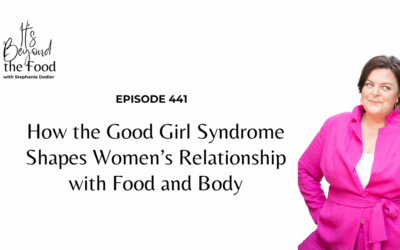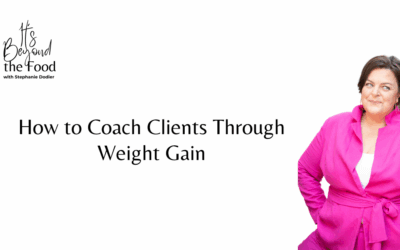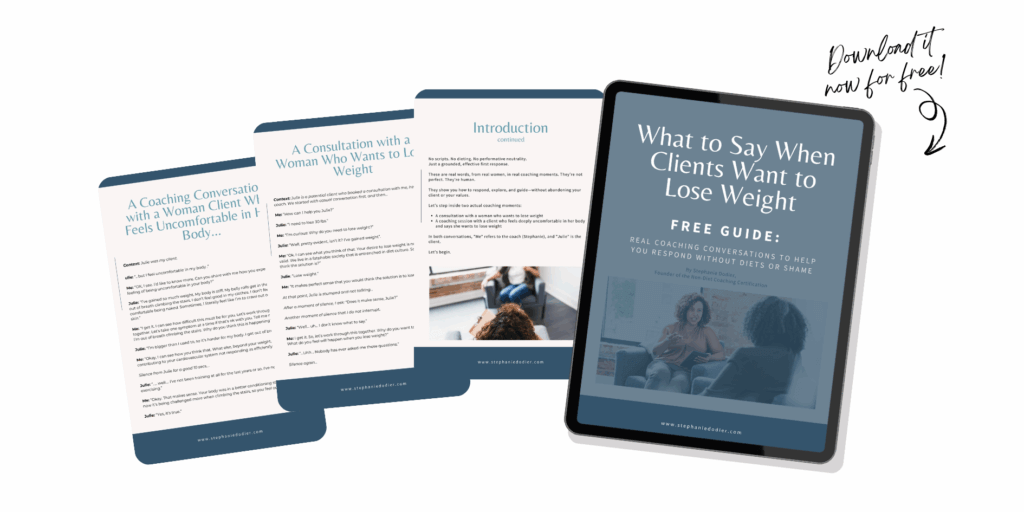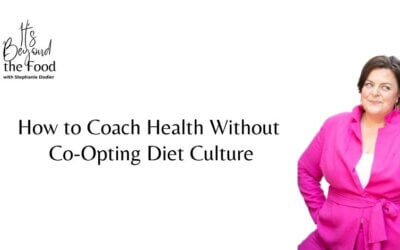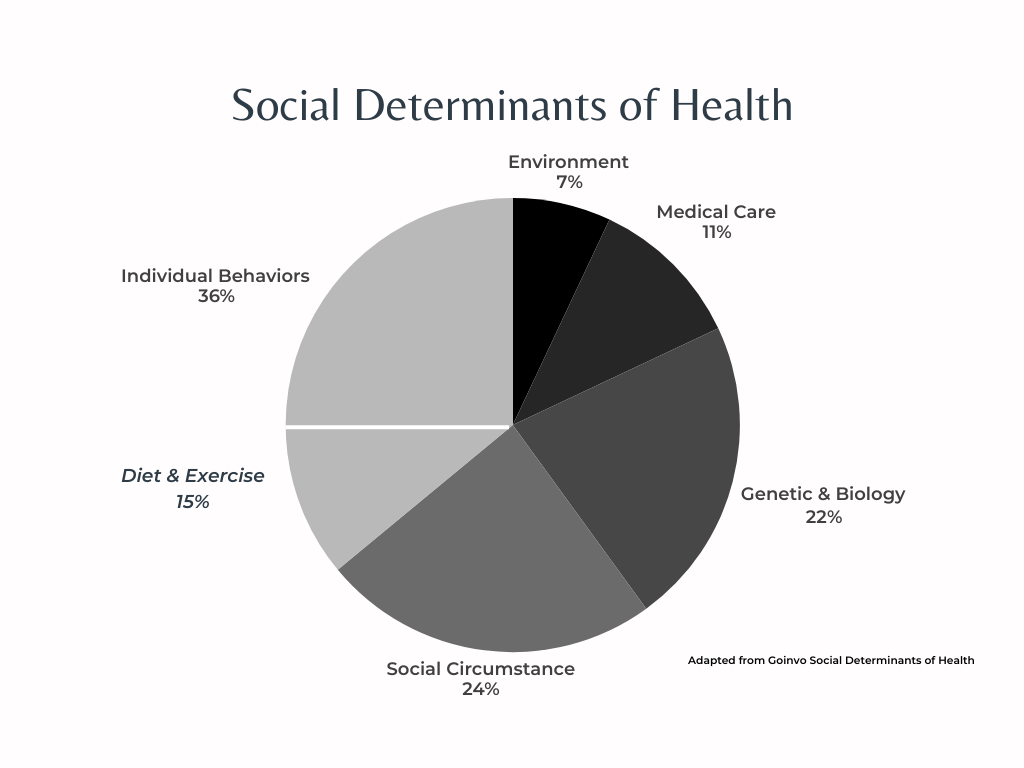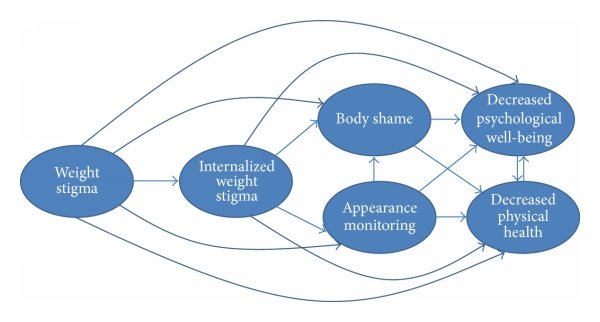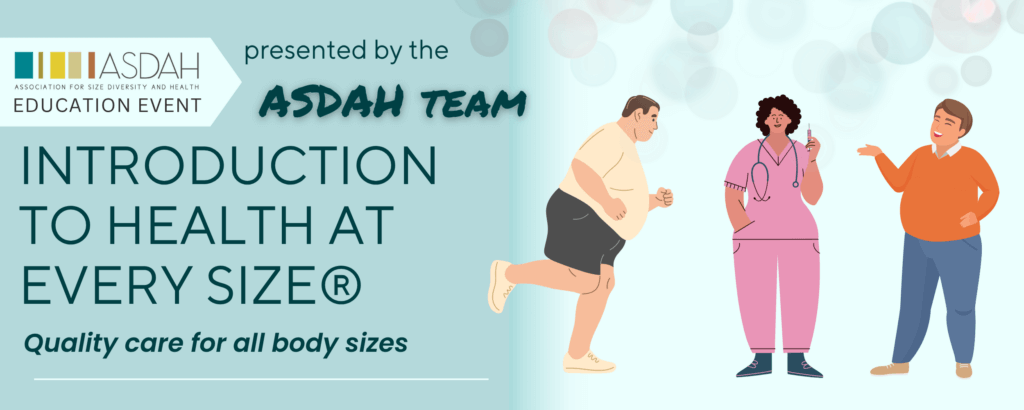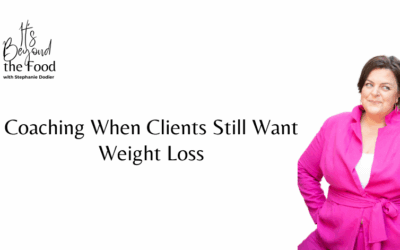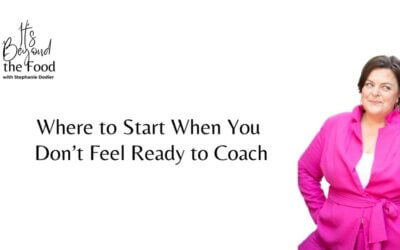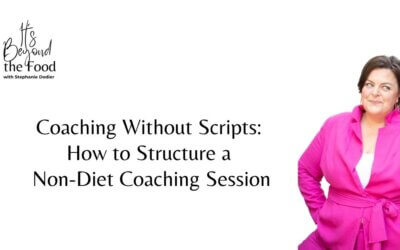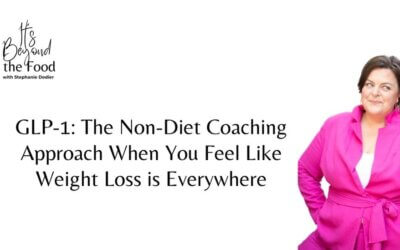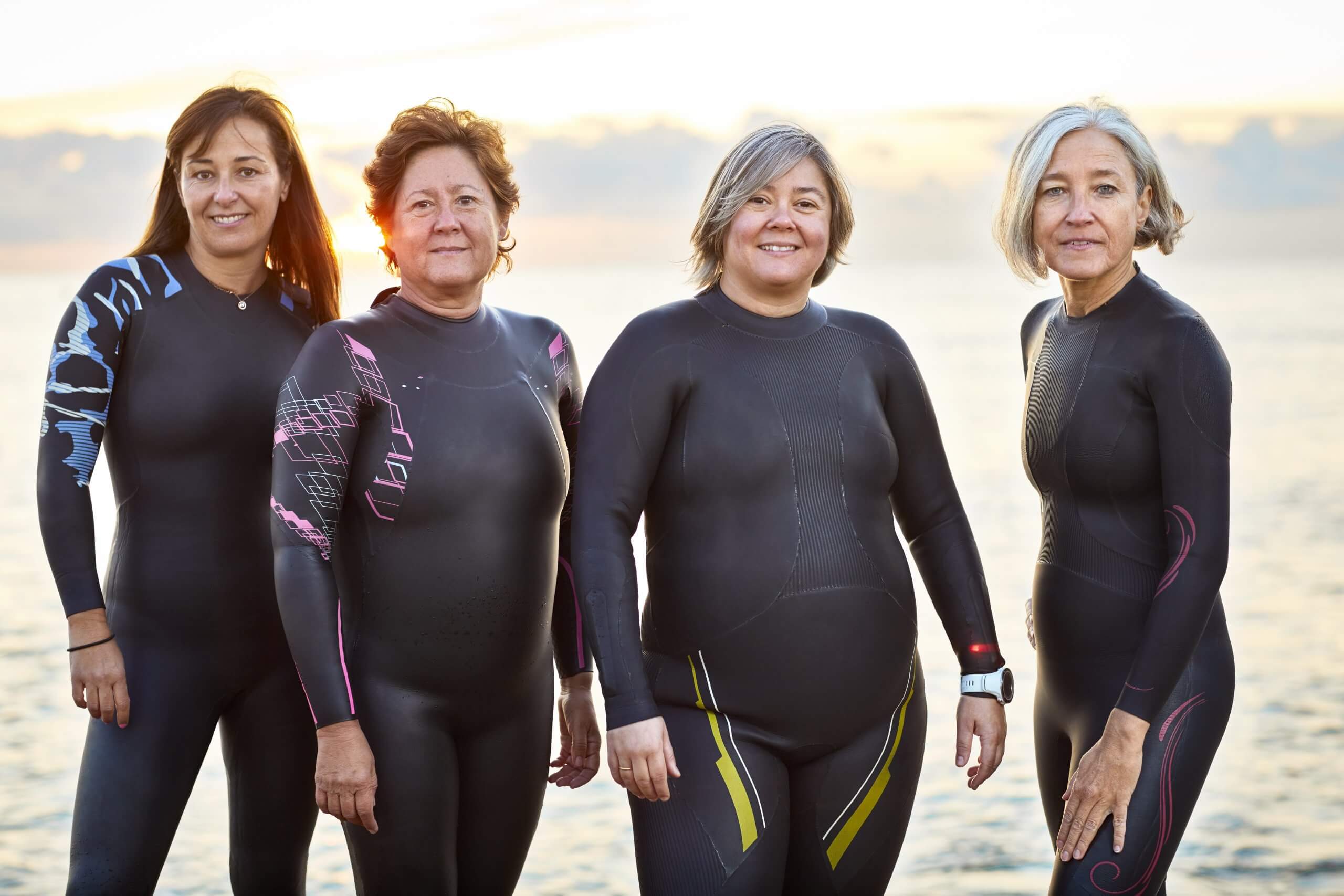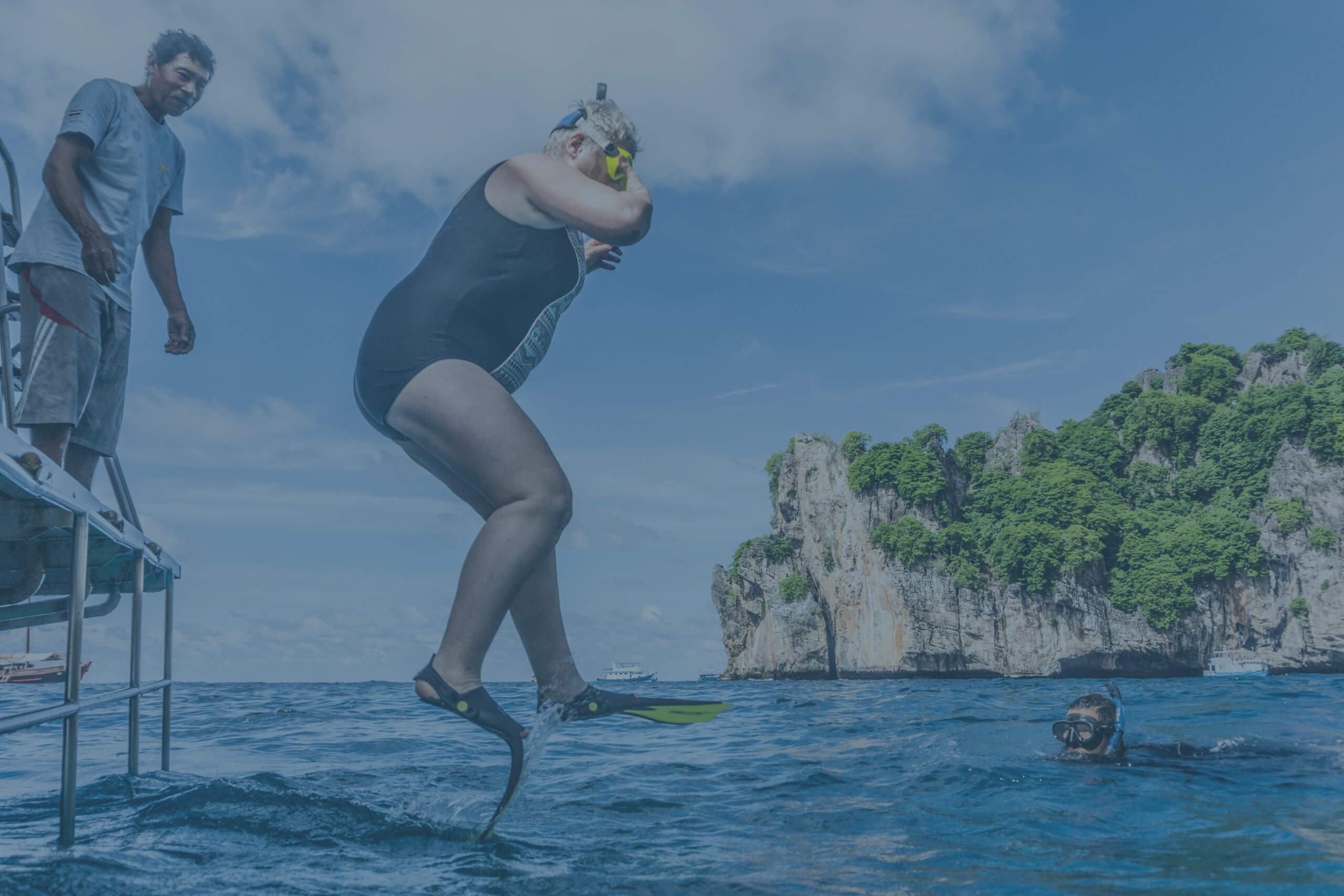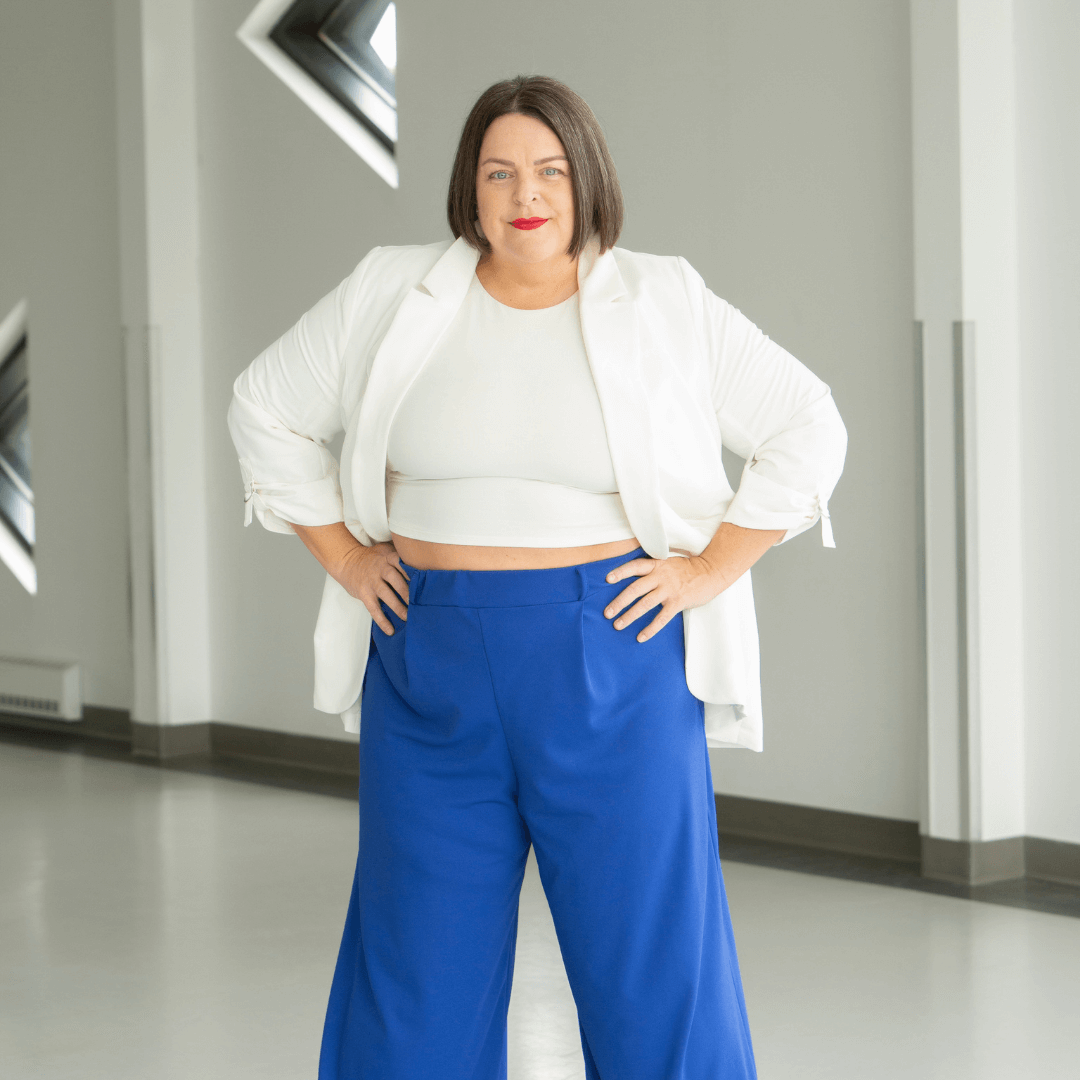

Welcome to
Beyond the Food Blog
A catalog of evidence-based articles written by Stephanie Dodier non-diet nutritionist, educator, and feminist business leader on all topics supporting the non-diet approach that will challenge everything you’ve been taught about food, health, and coaching.
Welcome to
Beyond the Food Blog
A catalog of evidence-based articles written by Stephanie Dodier Clinical Nutritionist on all topics supporting the non-diet approach to health.
Our Most Recent Articles
How the Good Girl Trauma Shapes Women’s Relationship with Food and Body
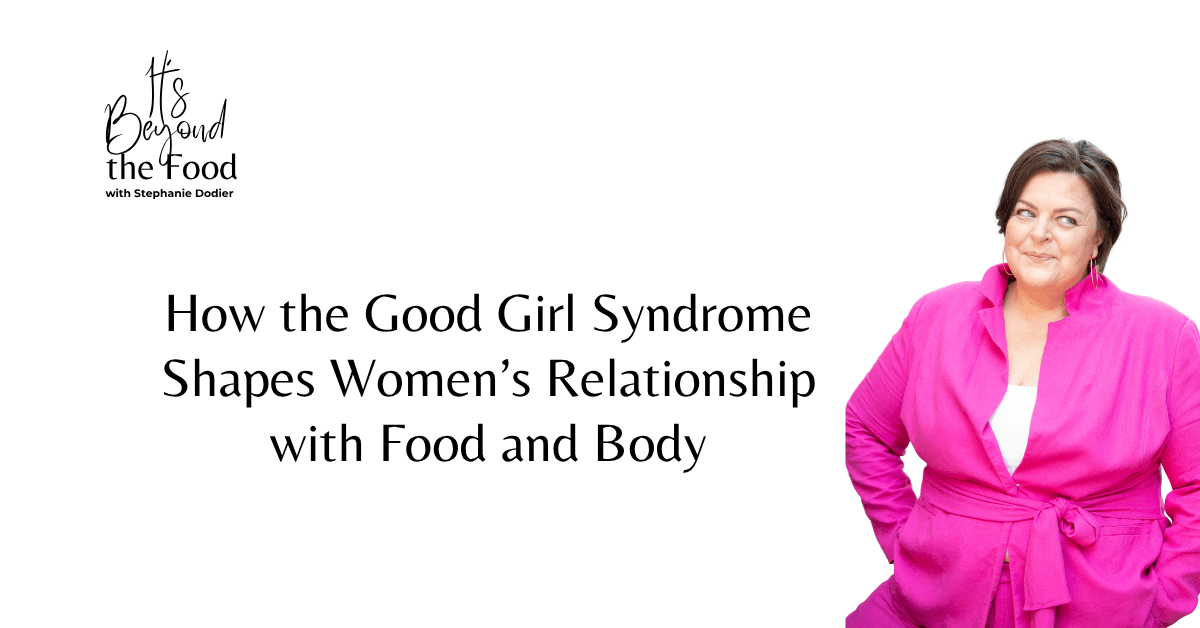

If you’re a health professional committed to coaching without co-opting diet culture, understanding Good Girl Trauma changes everything.
This trauma sits beneath many of the struggles your clients bring to you—food obsession, body dissatisfaction, burnout, perfectionism.
It’s not just about behavior; it’s about socialization. Women have been taught for generations that being “good” means self-denial, control, and compliance—and that belief quietly shapes how they eat, move, and care for their bodies.
Most women were raised to be “good girls.” Polite. Modest. Quiet. Helpful.
We learned early that our worth depended on how others perceived us—not how we felt about ourselves. This conditioning runs deep. It shapes our behavior, our confidence, and even our relationship with food and health.
What Is the Good Girl Trauma?
What many call the Good Girl Syndrome is better understood today as Good Girl Trauma—a psychological and social wound created by gendered expectations.
This trauma arises from the pressure to conform to deeply ingrained stereotypes of femininity: being agreeable, selfless, accommodating, and unproblematic. Under the surface of politeness and perfection, this conditioning erodes mental health and self-trust.
Good Girl Trauma often goes unnoticed because it hides behind what society rewards—compliance, caretaking, and achievement. It’s trauma disguised as success. It’s the exhaustion that comes from performing goodness rather than living authentically.
Over time, this pressure teaches women that love and belonging are conditional. To be accepted, we must not make mistakes, show anger, or take up too much space. We must constantly monitor how others feel about us. And that cycle—rooted in gender bias and reinforced by culture—quietly shapes every decision we make, including how we eat, move, and inhabit our bodies.
“Good Girl Trauma hides behind what society rewards—compliance, caretaking, and achievement. It’s trauma disguised as success.”
Common Signs of Good Girl Trauma
- Perfectionism: A belief that mistakes equal failure.
- Dependence on approval: Self-worth relies on praise and recognition.
- Fear of conflict: Disagreement feels unsafe, so we silence ourselves.
- Difficulty saying no: Boundaries feel selfish or risky.
- Excessive self-demand: The inner critic never rests.
- Emotional exhaustion: The pressure to appear “fine” leads to burnout and self-doubt.
Rather listen to the audio version of this blog? We’ve got you…
The Roots of Good Girl Trauma
To understand this trauma, we need to look at its origins. The “good girl ” archetype didn’t appear overnight—it’s centuries in the making.
Historical and Cultural Origins
The image of the “good girl” has deep roots in patriarchal structures and gender norms that dictated how women should behave. From fairy tales to religious teachings, women were taught that obedience, purity, and nurturing others defined their worth.
These messages created an enduring archetype: the woman who keeps everyone happy, asks for nothing, and sacrifices her own desires for the comfort of others.
Even today, these ideals linger. They influence how we parent, educate, and portray women in media. The “nice girl” may no longer wear a corset, but she still lives in the stories we tell and the standards we uphold.
Family Dynamics and Educational Systems
The pattern begins early. Girls are often praised for being quiet, cooperative, and helpful—while boys are encouraged to explore, debate, and take risks.
“Why can’t you be more like your sister? She always behaves.” “A polite girl doesn’t raise her voice.”
At home and in school, we internalize that good behavior equals love and safety. We learn that achievement and compliance bring praise, while assertiveness and self-expression invite criticism. The result? A lifelong fear of rejection and an instinct to prioritize others’ comfort over our own truth.
Media Influence
From childhood cartoons to women’s magazines, media reinforces these ideals.
The “good woman” is patient, nurturing, and self-sacrificing.
She gives, fixes, and smooths things over.
These portrayals shape not just what we see—but what we believe about ourselves. They create an invisible rulebook that measures our worth by how well we meet the impossible standard of being kind, thin, accommodating, and endlessly productive.
Growing Up to Fit the Mold
In my own life, being a “good girl” meant performing well and keeping everyone happy. I got good grades. I volunteered. I stayed quiet. I avoided standing out because being different felt unsafe.
One small moment stands out vividly. In seventh grade, I had hip surgery and spent three months at home. My parents hired a teacher to tutor me. One day, she told them my handwriting wasn’t “up to standard.” My letters were too big. My writing tilted slightly to the side.
That tiny critique turned into a family project to fix my handwriting. I remember sitting at the dining table, my parents hovering, as I practiced making my letters smaller and neater. The message was clear: don’t be different. Stay within the lines.
Not long after, my body changed—it no longer fit the “norm.” And just like that, I was taken to Weight Watchers.
That moment marked the beginning of a 25-year dieting career. The goal wasn’t health. It was conformity. I wanted to be a “good girl”—one who looked the way women were supposed to look.
Looking back, that moment wasn’t just about dieting—it was the beginning of my own Good Girl Trauma, where controlling my body became the proof that I was disciplined, worthy, and “good.”
“Controlling my body became proof that I was disciplined, worthy, and ‘good.’”
The Culture That Rewards Compliance
This isn’t just a personal story.
A Stanford University study found that the most desirable traits for women were compassionate, warm, cheerful, soft-spoken, and loyal.
For men, the top traits were independent, assertive, dominant, and decisive.
In short: women are valued for being soft; men for being strong.
And both sexes internalize this script. We grow up enforcing it—on ourselves and on each other.
Psychological Consequences of Good Girl Trauma
The mental health impact of Good Girl Syndrome runs deep. What looks like “having it all together” often masks anxiety, exhaustion, and a fragmented sense of self.
Mental Health Issues
- Anxiety: The constant fear of disappointing others or stepping out of line can be paralyzing.
- Depression: Suppressing your true self leads to emptiness and disconnection.
- Low self-esteem: Your worth feels conditional—based on approval rather than authenticity.
Struggle with Identity Formation
Good Girl Trauma creates a disconnect between who we are and who we think we should be.
We lose sight of our desires and instincts because they’ve been buried under performance.
- Conflicted self-identity: Torn between the authentic self and the “acceptable” self.
- Neglected interests: We abandon passions that don’t fit the image of the “good” woman.
Impact on Relationships
The trauma doesn’t just affect the self—it spills into relationships.
- Avoidance of conflict: Keeps relationships “peaceful” but shallow.
- Suppressed personality: Only the accommodating version of you is visible.
- Critical self-view: Frustration and shame amplify when you can’t meet impossible standards.
The Emotional Cost of Being a “Good Girl”
Good Girl Trauma teaches women to repress emotion. Anger, frustration, and grief are labeled “unfeminine.” So we turn inward, channeling pain into self-control or self-criticism.
Diet culture thrives in this silence. It tells women that emotional eating is weakness, that hunger is moral failure, that our body is a problem to be fixed. In truth, food often becomes the outlet for emotions we were never allowed to express.
We numb because we were never taught to feel. We overachieve because we were never taught to rest. We diet because we were taught to disappear.
How Good Girl Trauma Shapes Our Relationship with Food and Health
Good Girl Trauma doesn’t stop at emotional well-being—it infiltrates how women relate to food, health, and their bodies.
When we’re taught from childhood to suppress emotions and meet impossible standards, our body becomes the stage where that conflict plays out. We use control—of food, weight, and movement—to manage anxiety and maintain a sense of order in a world that demands perfection.
The thin ideal becomes the goalpost through which women prove they are “good.” A disciplined body signals compliance. A smaller body earns approval. And a body that resists shrinking becomes a source of shame.
For many, dieting begins as a socially sanctioned way to “be good.”
- Eating “clean” becomes proof of discipline.
- Pushing harder at the gym becomes a way to earn worth.
- Shrinking the body becomes a stand-in for shrinking emotional pain.
The result is not health—it’s disconnection. We lose trust in our bodies’ cues and confuse self-punishment with self-care.
In my work with women, this is often the turning point: realizing that their food and body struggles were never about willpower—they were about approval. Diet culture simply took the Good Girl script and sold it back as “wellness.”
Healing begins when we stop treating our bodies as projects to fix and start seeing them as partners in our recovery. When we rebuild trust with hunger, rest, and pleasure, we reclaim more than health—we reclaim autonomy.
“The thin ideal is the goalpost through which women prove they are good—discipline becomes morality, and shrinking becomes virtue.”
Coping Mechanisms and Unhealthy Behaviors in Good Girl Trauma
To survive the unrelenting pressure of perfection and approval, many women develop coping mechanisms. Some may look successful from the outside—but they often deepen the wound.
Common Coping Strategies
- Perfectionism: The endless pursuit of flawlessness to avoid criticism.
- Overworking: A constant drive to prove worth through productivity.
- People-pleasing: Prioritizing everyone else’s needs to maintain approval and safety.
Consequences of Maladaptive Coping
- Burnout: The inevitable crash from chronic overperformance.
- Neglect of personal needs: Health, joy, and rest are sacrificed for others.
- Relationship strain: Either overdependence on approval or emotional withdrawal.
The Cycle of People-Pleasing
If you struggle with people-pleasing, it’s not a character flaw—it’s a survival strategy. It was once how you stayed safe, loved, and accepted. But as adults, it becomes a cage.
Saying no feels like betrayal. Rest feels indulgent. And asserting needs feels wrong.
These learned patterns make it hard to set boundaries or care for ourselves without guilt. But awareness is the first step toward freedom.
The Duality Within
Inside many women lives a tension: the Good Girl we were taught to be versus the authentic woman we are becoming.
That duality explains why so many of us struggle with food, body image, and self-worth. The problem isn’t willpower—it’s the collision of conditioning and identity.
Once we recognize this, we can start rewriting the story.
“Healing from Good Girl Trauma isn’t rebellion—it’s reclamation.”
Reclaiming Our Power
Healing from Good Girl Trauma isn’t about rebellion—it’s about reclamation. We move from perfectionism to self-compassion. From compliance to authenticity. From managing others’ comfort to honoring our truth.
When we stop chasing approval, we reclaim our voice, our body, and our worth. And in doing so, we model something revolutionary for the next generation: that being a woman isn’t about being “good.” It’s about being whole.
Ready to Support Clients with Good Girl Trauma?
You can access all of our services on our work with us page. We have a number of programs and service levels enabling us to serve most women:
Free Resources and Masterclasses: Get started and get to know us better!
Private coaching with Stephanie and her team Stephanie and her team of Certified Non-Diet Coaches are waiting to support you in a one-to-one setting with an individualized plan.
Non-Diet Coaching Certification for professionals ready to integrate the Going Beyond The Food Method™️ in their practice and for women wanting to become a Certified Coach and build a business coaching other women beyond the food.
How to Coach Clients Through Weight Gain Without Prescribing Weight Loss Tactics Or Fear
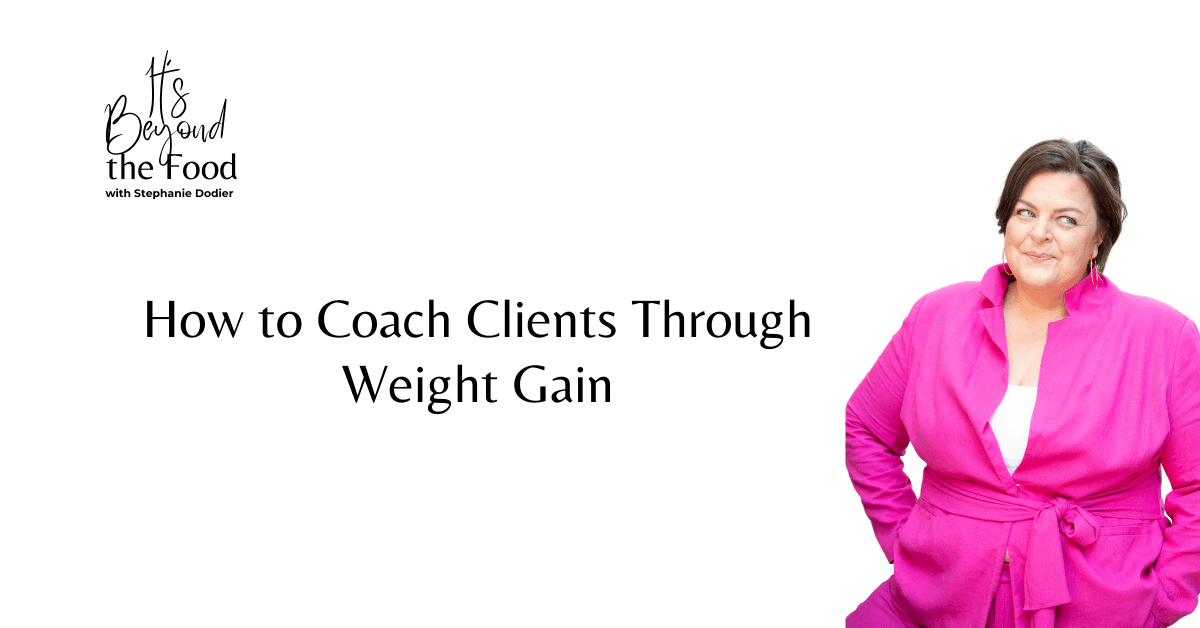

How do I coach a client who gains weight without selling a diet?
If you’ve ever asked yourself that, you’re not alone.
When your client gains weight during coaching, it can feel like the sky is falling—for them and for you.
They’re panicking. You might be panicking. And if you’re not careful, diet culture will sneak into your session and try to “fix” the situation by prescribing weight loss.
Let me be clear: weight gain is not a coaching emergency.
It’s a coaching opportunity.
And this blog will show you exactly how to navigate that moment powerfully, ethically, and without betraying your values.
First, Let’s Talk About You, Coach
It’s completely normal to feel shaken when a client wants to quit because of weight gain. You might feel like you failed them. Like you’re not a good enough coach. Like this weight gain is your fault.
It’s not.
Clients gaining weight isn’t a failure of your method—it’s a reflection of what happens when we untangle people from years of restriction, weight obsession, and diet trauma.
Before you coach your client through weight gain, you need to coach yourself. That means regulating your nervous system, noticing your thoughts, and holding your own discomfort with compassion.
You’re the container. Get grounded before you hold space for theirs.
Rather listen to the audio version of this blog? We’ve got you…
7 Steps to Coach Clients Through Weight Gain
This is the same process I teach inside the Non-Diet Coaching Certification. It’s trauma-informed, grounded in cognitive-behavioral principles, and built for real-world coaching.
1. Neutralize Weight Gain
Weight gain is not good or bad. It’s a neutral circumstance—just like your hair growing or your nails getting longer.
Start the conversation by helping your client see weight gain as neutral. Use analogies. Validate their distress without reinforcing fatphobia.
“What are you making this weight gain mean about you?”
2. Normalize the Distress (Without Colluding)
Yes, weight gain feels intense. Especially for those socialized as women. But your job is not to make it go away.
Your job is to hold space for the emotion without co-signing the belief that weight gain is inherently bad.
Acknowledge their despair. Then gently explore where it comes from.
“How has your identity shaped your beliefs about weight gain?”
3. Deconstruct Catastrophizing Thoughts
Fear tells your client that 15 pounds today means 500 pounds tomorrow. That’s catastrophizing. And it keeps them stuck.
Help them unpack their beliefs and fears one by one. Gently question the “truth” of their assumptions.
“Is it true that all these things will happen if your body changes?”
4. Regulate the Nervous System
No coaching breakthrough happens in a state of panic. Teach your client how to ride the wave of their emotion, not suppress it.
Use breathing, somatic grounding, and co-regulation to help them move from reactivity to response.
“Where do you feel that fear in your body? Let’s sit with it together.”
5. Offer New Solutions (Beyond Weight Loss)
Once they’re grounded, co-create new options:
- Body image healing (ex: body neutrality)
- Health-promoting behaviors without a weight focus
- Confidence work that isn’t body-dependent
This is the moment to remind them: their goals are still valid. And weight loss was never the goal of this coaching relationship.
And if you need help navigating these conversations? Download my free guide: What to Say When Clients Want to Lose Weight
6. Hold Space for Their Decision
This is where you step back. Don’t push. Don’t fix.
Let them choose how they want to move forward. Your job is to create the safest possible container for their autonomy—not your opinion.
“Which of these options brings you closer to the life you want?”
7. Coach Yourself, Too
Your client gaining weight will bring up your own fears: about money, credibility, retention, results. You need tools to regulate your nervous system and coach your own thoughts.
This is why self-coaching is part of our certification. Because how you experience a coaching rupture determines how safely you can guide your client through one.
Weight Gain Isn’t a Threat—It’s a Gateway
Most clients come to coaching because they’re stuck in a cycle. Weight gain is usually the trigger that got them to finally reach out.
When that fear shows up again during the work? That’s your moment.
This is where the transformation happens.
Can you meet them there, without flinching? Without trying to fix it with food rules or smaller-pants promises?
If yes, that’s the mark of a confident coach.
Ready to Coach Without Fear?
You can access all of our services on our work with us page. We have a number of programs and service levels enabling us to serve most women:
Free Resources and Masterclasses: Get started and get to know us better!
Private coaching with Stephanie and her team Stephanie and her team of Certified Non-Diet Coaches are waiting to support you in a one-to-one setting with an individualized plan.
Non-Diet Coaching Certification for professionals ready to integrate the Going Beyond The Food Method™️ in their practice and for women wanting to become a Certified Coach and build a business coaching other women beyond the food.
How to Coach Health Without Co-Opting Diet Culture
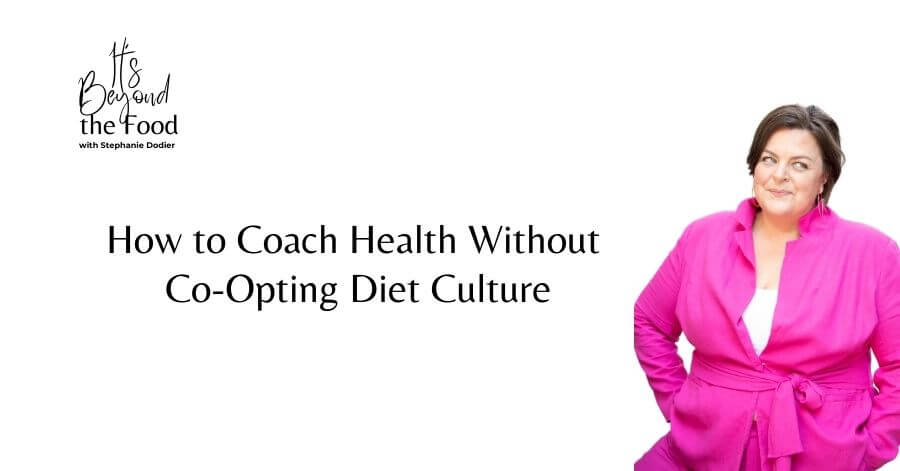

In the world of health and wellness, one question keeps coming up for thoughtful, anti-diet professionals: Can I coach health without reinforcing diet culture? If that question’s been echoing in your mind, you’re not alone—and you’re not off track.
Most of us were trained inside systems that equate weight with health. We learned to treat weight loss as the goal, the cure, the gold standard. And our clients? They’ve been socialized in the exact same paradigm.
But what if we told you there’s a better way? One that honors your clients’ whole humanity—body, mind, and spirit—without falling back into weight-centric scripts. That way is called weight-neutral health coaching. And this guide is your first step into that world.
What Is Diet Culture—and Why It Matters
Before we talk alternatives, let’s name the problem: diet culture.
Diet culture is a belief system that assigns moral value to body size, promotes thinness as health, and pushes restrictive eating as virtue. It shows up in our training programs, our textbooks, and even the well-meaning advice we give clients.
And it’s not neutral.
- It leads to body shame and disordered eating
- It reinforces systemic oppression
- It narrows health to physical appearance
As coaches and practitioners, when we operate inside this framework—whether knowingly or not—we reinforce harm. Even with the best of intentions.
Rather listen to the audio version of this blog? We’ve got you…
What Is a Weight-Neutral Approach to Health?
Weight-neutral health coaching begins with the radical idea that weight is not the defining factor of someone’s health.
Instead, it looks at health as multi-dimensional:
- Physical
- Mental
- Emotional
- Spiritual
- Social
It considers the whole person, not just the number on the scale. That includes their identities, their lived experiences, and their environment—the full spectrum of what’s known as the social determinants of health.
Why Coaching Health Without Diet Culture Matters
Let’s get one thing straight: this isn’t about being soft. It’s about being effective.
Weight-centric health coaching doesn’t work long-term. It creates yo-yo cycles, disconnection, and shame.
Weight-neutral coaching, on the other hand:
- Promotes sustainable behavior change
- Centers bodily autonomy and emotional safety
- Encourages curiosity instead of judgment
It’s not just possible—it’s essential. And your clients are ready for it.
8 Tangible Ways to Coach Health Without Co-Opting Diet Culture
You don’t need to overhaul your entire practice overnight. Here are 8 places to start:
1. You Can’t Hate Yourself Into Health
Most clients arrive believing they have to suffer to succeed. Your job? Help them unlearn that.
Focus on healing body image and building worthiness that isn’t tied to appearance. Research shows poor body image is a predictor of disordered eating. Body dissatisfaction is the best known contributor to eating behavior disturbance.
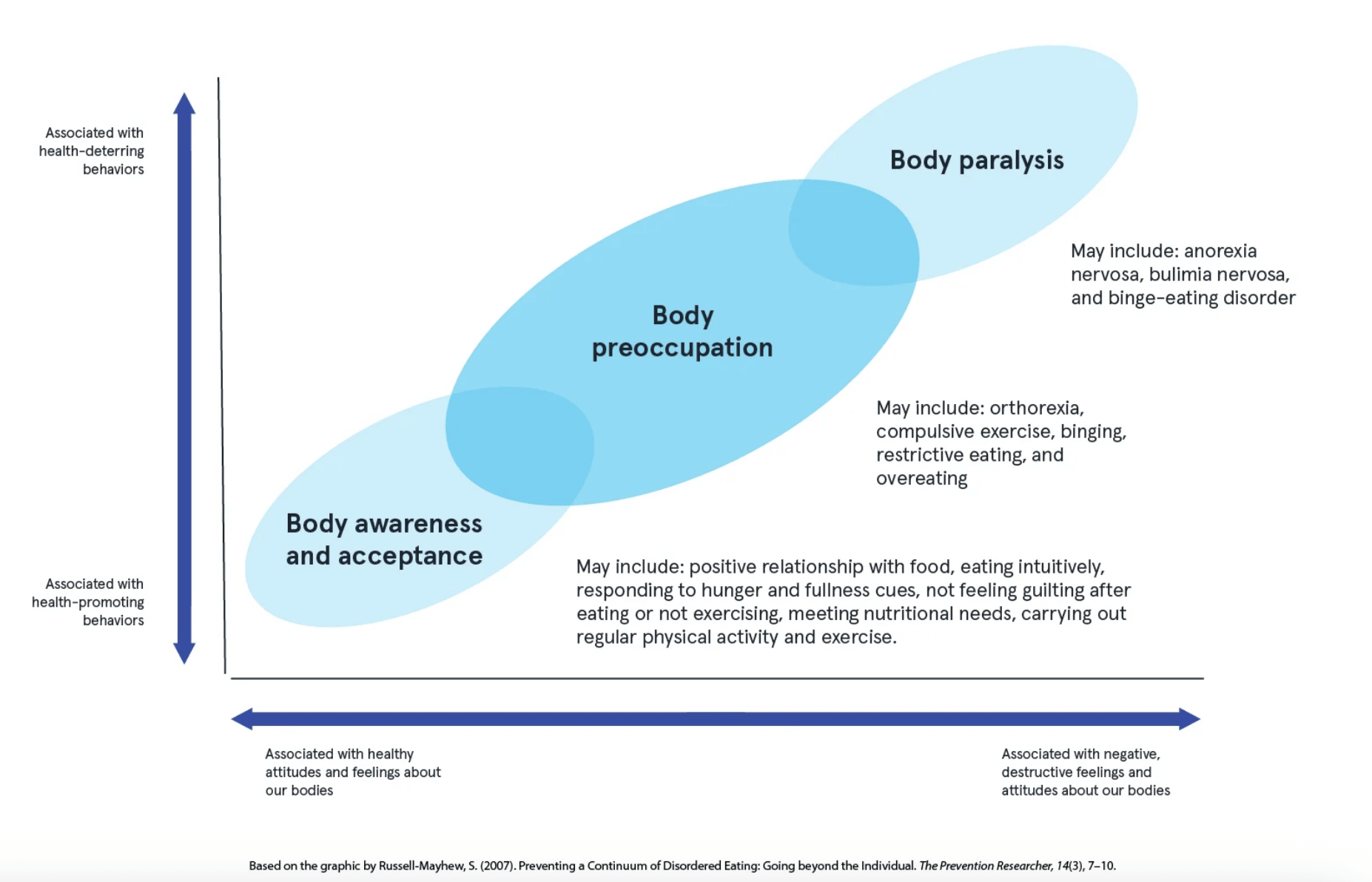

2. You Can’t Stress Yourself Into Health Either
Health behaviors rooted in guilt or stress aren’t sustainable. Teach clients how emotional regulation, nervous system care, and rest impact their well-being.
This means less pushing, more pausing.
3. Coach the Mind, Not Just the Meal Plan
Clients’ thoughts create their emotions, which drive their behaviors. Enter: Cognitive Behavioral Coaching.
You don’t need to be a therapist to help clients reframe toxic beliefs about health, food, or their bodies. You need a framework that honors their full experience.
4. Reframe Health as Self-Care
True health isn’t a checklist. It’s how we care for ourselves daily—in ways that actually feel good.
Help clients shift from punishing routines to compassionate care across mental, physical, and emotional dimensions.
5. Use Self-Compassion as a Coaching Tool
Perfection isn’t the goal. Consistency is. And consistency requires grace.
When clients “fall off track,” teach them how to respond with compassion, not criticism. That’s how behavior change sticks.
6. Sleep Is a Health Intervention
It’s not just about what we eat or how we move. Health coaching includes life coaching.
Poor sleep habits often trace back to deeper issues: boundaries, people-pleasing, or lack of support. Dig there.
7. Repair the Relationship to Food
Before diving into nutrition education, clients need to relearn how to eat without fear.
Start by restoring hunger, fullness, and satisfaction cues. This lays the foundation for sustainable nourishment.
8. Teach Gentle Nutrition, Not Food Rules
Once the food relationship is stabilized, you can layer in gentle nutrition—flexible, realistic guidance that doesn’t require perfection.
Simplicity is key. Complexity creates dependence. Your clients need tools, not more rules.
What About the Research?
There is research supporting weight-neutral health approaches—though it’s often overshadowed by the sheer volume of weight-centric studies. Still, the evidence we do have tells a compelling story.
One of the most comprehensive reviews, The Weight-Inclusive versus Weight-Normative Approach to Health, argues that focusing on well-being rather than weight loss results in better physical and psychological outcomes. This review highlights the limitations of weight-centric approaches and makes a strong case for reorienting care around behaviors, not bodies.
Similarly, studies on the Health at Every Size® (HAES) model show improvements in health markers like blood pressure, cholesterol, eating behaviors, and psychological well-being—without intentional weight loss. These findings suggest that when we de-emphasize weight, we don’t lose effectiveness—we gain sustainability.
Another meta-analysis examining weight-neutral interventions concluded that these approaches can support long-term health behavior changes and reduce disordered eating patterns. They emphasize client autonomy and psychological safety, two key ingredients for transformation. Review that research here.
If you’re new to the HAES model or want to understand its principles, start here with ASDAH—the Association for Size Diversity and Health.
How to Coach Health Without Co-Opting Diet Culture: Podcast Library
Looking to learn on the go? Here are essential podcast episodes from our library:
- Failure of dieting – The facts (Ep. 286)
- Weight Set Point (Ep. 214)
- The BMI and why it’s no effective measure of health (Ep. 216)
- What is Wellness Culture & Healthism (Ep. 228)
- Health Goals versus Weight Loss Goal (Ep. 264)
- The Weight Neutral Approach to Health (Ep. 208)
Final Thoughts: Coaching Beyond the Scale
Coaching health without diet culture isn’t a compromise. It’s a revolution.
It’s how we help clients unlearn shame, rebuild trust, and finally take up space—in their bodies and their lives.
And if you’re thinking, This is the kind of coach I want to be… you’re in the right place.
Ready to Coach Health Without Co-Opting Diet Culture?
You can access all of our services on our work with us page. We have a number of programs and service levels enabling us to serve most women:
Free Resources and Masterclasses: Get started and get to know us better!
Private coaching with Stephanie and her team Stephanie and her team of Certified Non-Diet Coaches are waiting to support you in a one-to-one setting with an individualized plan.
Non-Diet Coaching Certification for professionals ready to integrate the Going Beyond The Food Method™️ in their practice and for women wanting to become a Certified Coach and build a business coaching other women beyond the food.
How to Coach Clients Who Still Want Weight Loss (without co-opting diet culture)
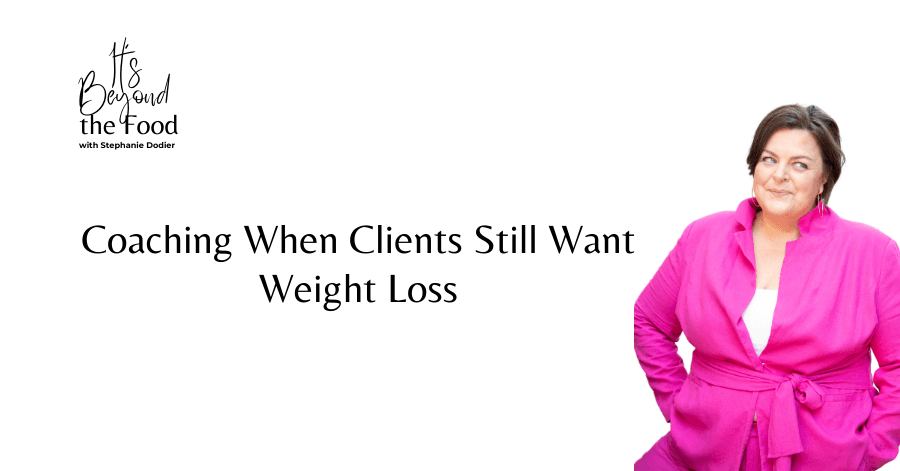

When a client says, “But I want to lose weight,” do you freeze up? Get a little panicky? Feel unsure how to respond without compromising your values?
You’re not alone.
If you’re a non-diet health coach, nutritionist, or therapist, these moments are inevitable. Weight loss will come up. It’s not a matter of if, but when.
What you do in that moment? That’s what defines your impact. And your client’s outcome.
In this guide, I’ll show you how to navigate those conversations without persuasion, shame, or silence. Instead, we’ll coach into the desire to lose weight—with clarity, confidence, and compassion.
Rather listen to the audio version of this blog? We’ve got you…
What Drives the Desire to Lose Weight?
The desire to lose weight isn’t a character flaw. It’s not even an objective fact. It’s a thought — one shaped by culture, identity, past experiences, and systemic oppression.
Clients don’t wake up one morning and randomly decide they should shrink their bodies. That desire emerges from layers of conditioning: diet culture, fatphobia, patriarchy, and healthism. Add to that personal history (like weight gain experiences or medical shaming), and it’s easy to see how the belief “I need to lose weight” becomes automatic.
The result? Thoughts like:
- I’ll get sick.
- I won’t fit in my clothes.
- My partner deserves better.
- People will think I’m lazy.
Which then trigger shame, disgust, or rejection, often driving clients right back into dieting, obsessing, or abandoning intuitive eating.
This cycle is powerful—but it can be interrupted. And that’s where coaching comes in.
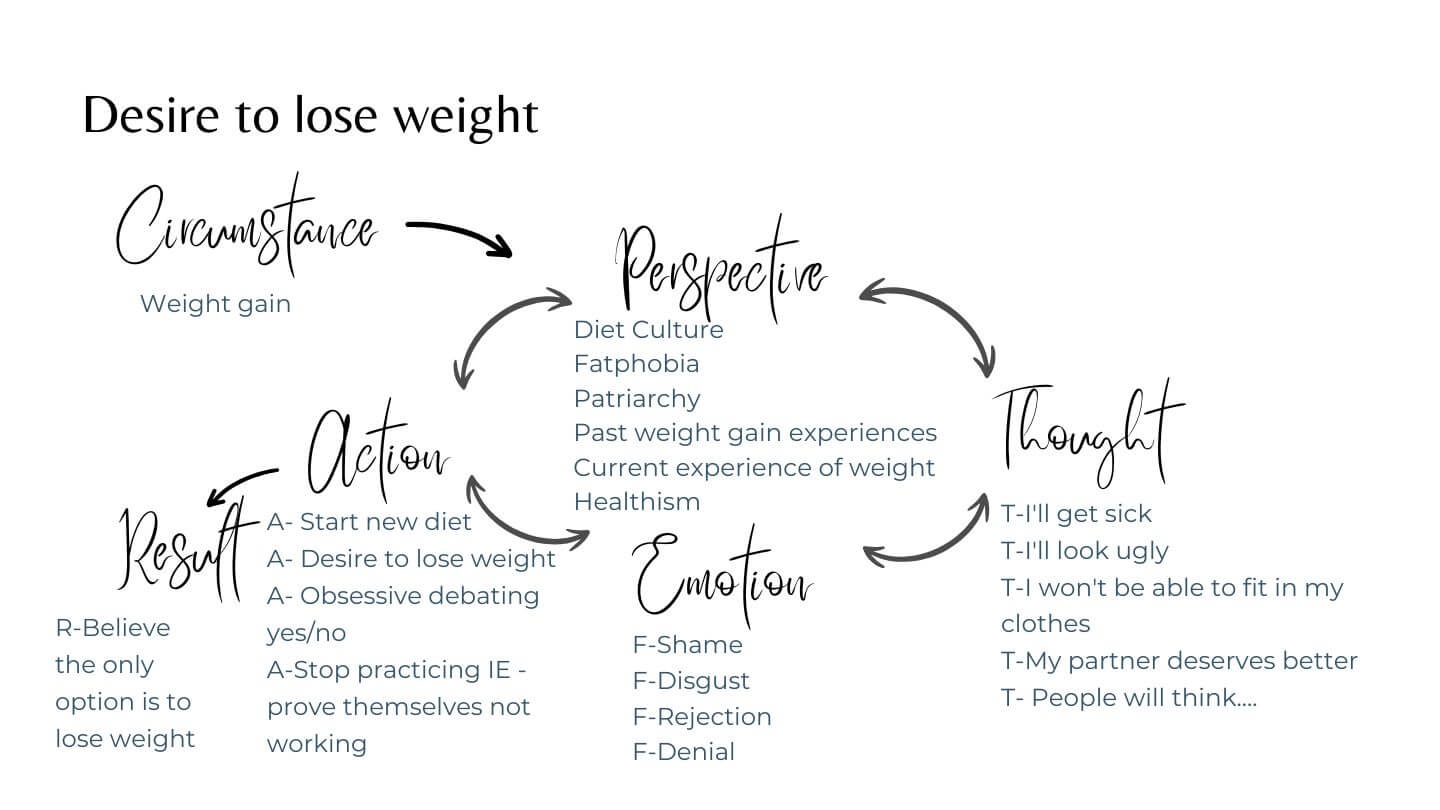

This visual framework captures how weight loss desire gets created and reinforced. It’s not proof that your client must lose weight. It’s a map showing the cultural, emotional, and behavioral forces at play. As coaches, we don’t fight the thought directly. We explore what’s underneath it.
From Panic to Curiosity: How to Respond
Your job is not to talk your client out of wanting to lose weight. It’s to explore why they want it.
Here are questions that move the conversation from fear to clarity:
- What are you hoping weight loss will do for you?
- If weight weren’t a factor, what would feeling good look like?
- What would being in a smaller body make possible?
- What do you think would change if weight wasn’t an issue anymore?
- Can we talk about what weight loss represents for you?
Remember: People don’t want the process of losing weight. They want the outcome they imagine is on the other side.
Confidence. Comfort. Acceptance. Health. Safety.
That’s the real coaching work.
What Putting Weight Loss “On the Back Burner” Actually Means
You’ve probably heard this advice before: “Put weight loss on the back burner.”
But here’s the nuance:
You’re not ignoring their desire. You’re just removing it from center stage.
Use This Analogy:
Imagine your client’s desire to lose weight is a pot of soup on the front burner. It’s been there for years, taking all the attention. What we do is move that pot to the back burner—still warm, still present—so we can cook something else at the front. Something like energy, joy, or freedom.
Use this coaching prompt:
“What if we gave the desire to lose weight less airtime? Not because it’s wrong—but because there’s more to you than your weight.”
Note: We teach this exact model inside the Non-Diet Coaching Certification, where coaches learn to meet this moment with skill, not silence.
The Motivation Trap: Why Weight Loss Goals Backfire
When weight loss is the motivator for behavior change, the client is stuck in an “if-then” trap:
- If I don’t lose weight, then it wasn’t worth it.
This type of extrinsic motivation is unsustainable. In contrast, intrinsic motivators like stress relief, energy, or joy drive long-term change.
A 2006 study on midlife women found that those who exercised for weight loss walked 2.5 times less than those motivated by energy or stress relief [Segar et al., 2006].
So when we shift the focus, we don’t just preserve body autonomy. We increase the likelihood of meaningful, lasting change.
For more on this, explore:
🎧 Listen here: How to be healthier without losing weight
How to be healthier without losing weight
🎧 Listen here: Weight neutral health pro and cons
Weight neutral health pro and cons
Your Client Wants What’s on the Other Side of Weight Loss
Here’s the truth:
Your client doesn’t want the diet. They want what they think the weight loss will give them.
That’s what we coach.
Here are some common “other side of the river” desires:
- Less physical pain
- Better mobility
- More energy
- Emotional safety
- Confidence
- Peace around food
- Social belonging
- Control over health
Help your clients see that these outcomes are available without shrinking their bodies.
And if you need a clear, harm-reducing way to frame this in session or consults, I created a free script for you: Download the guide.
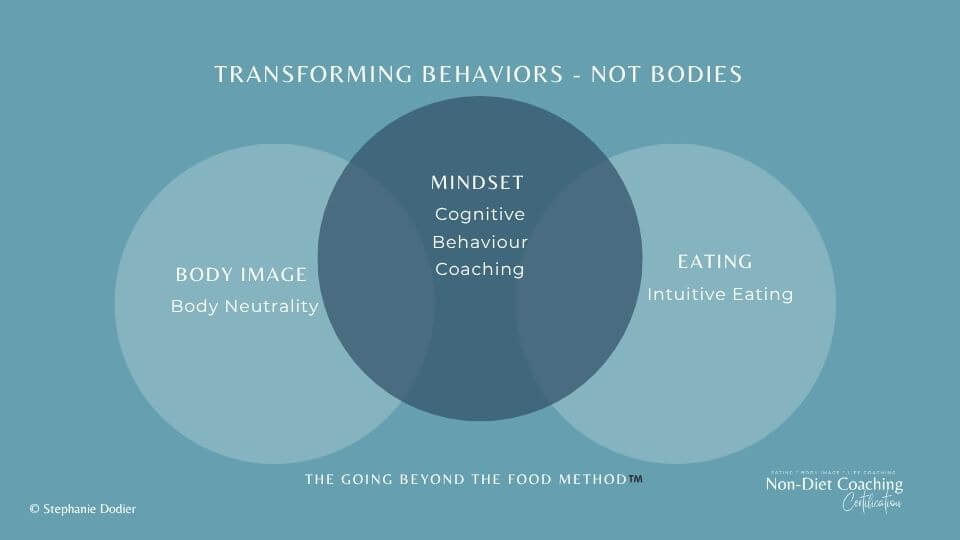

This is the foundation of our work: shifting from body control to behavior change. From managing appearance to cultivating resilience, energy, and trust.
Final Thoughts: This Is Our Coaching Moment
If we don’t meet the desire to lose weight with nuance and skill, someone else will. And likely with a diet plan.
We don’t coach bodies. We coach behaviors, beliefs, and the stories beneath them.
So let’s do it well.
If you’re ready to lead conversations that empower rather than persuade—to coach at the root instead of react to the symptom—join us inside the Non-Diet Coaching Certification.
That’s where we train professionals to do this work.
Need Help in Coaching Clients Who Still Want Weight Loss?
You can access all of our services on our work with us page. We have a number of programs and service levels enabling us to serve most women:
Free Resources and Masterclasses: Get started and get to know us better!
Private coaching with Stephanie and her team Stephanie and her team of Certified Non-Diet Coaches are waiting to support you in a one-to-one setting with an individualized plan.
Non-Diet Coaching Certification for professionals ready to integrate the Going Beyond The Food Method™️ in their practice and for women wanting to become a Certified Coach and build a business coaching other women beyond the food.
How to Guide Behavior Change Without “Fix it” Approach
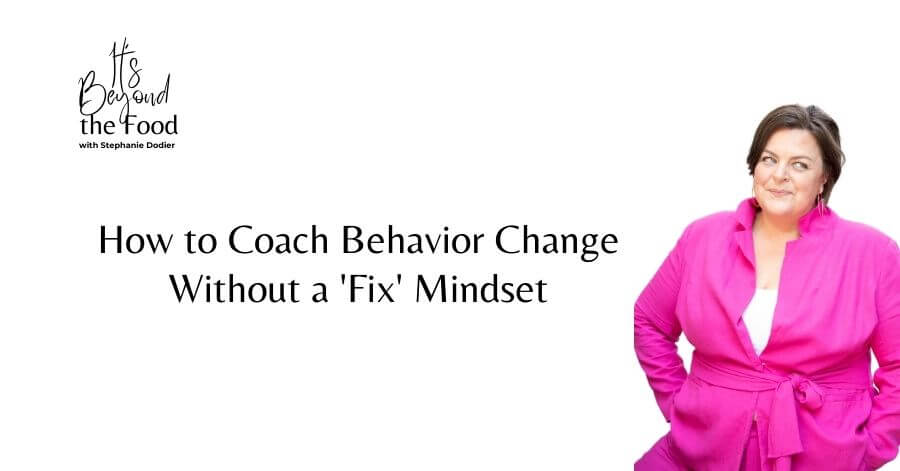

Health coaches and non-diet professionals, let’s have a real talk. If you’ve ever caught yourself jumping straight into “fixing” mode the minute a client brings up an eating or movement habit they want to change, you’re not alone. This impulse is deeply wired into how we’ve been trained—especially those of us coming from traditional health, nutrition, or fitness programs.
But here’s the kicker: trying to fix behavior without first understanding it doesn’t lead to long-term change. It leads to shame, overwhelm, and a lot of ghosted coaching sessions. Let’s unpack why that is—and how to shift into an approach that centers agency, emotional safety, and sustainable transformation.
The Problem with the “Fix It” Mindset
Most health professionals were taught a version of behavior change that goes something like this:
- Identify the “bad” habit.
- Provide intellectual reasons to change it.
- Suggest solutions (meal plans, exercise routines, tips).
- Expect compliance.
This model might look productive at first. But it often leads to clients feeling overwhelmed, ashamed, or like they’re constantly failing. Why? Because behavior isn’t just about logic—it’s about emotion, thought patterns, and nervous system regulation.
Jumping straight to “solutions” bypasses the very root of the issue. It reinforces a health narrative based in healthism, perfectionism, and control.
A New Approach: Cognitive-Behavioral Coaching
Instead of fixing, let’s focus on understanding. Inside the Non-Diet Coaching Certification, we teach a trauma-informed, cognitive-behavioral model rooted in weight-neutral, anti-oppressive principles. The goal? Sustainable health behavior change that respects autonomy and lived experience.
Our 4-Step Coaching Process:
1. Understand How Behavior Is Created
Behavior is not random. It’s a byproduct of how we think and feel about a situation.
For example, emotional eating isn’t a failure of willpower. It’s often a nervous system strategy to cope with shame, stress, or unmet needs.
Want to learn more? Here’s how to create motivation in a weight neutral health approach.
Want the video version on how to create motivation in weight-neutral health approach? Check out Stephanie’s Instagram Live here.
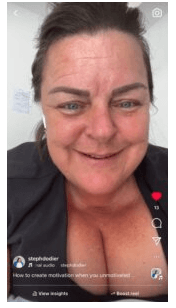

2. Investigate the Client’s Internal Environment
Use powerful questions to unpack the client’s thoughts, beliefs, and emotions around the behavior.
Ask questions like:
- What do you believe about the food you’re struggling with?
- What do you make your eating pattern mean about you?
- Describe your “ideal” eating day. Where did that idea come from?
- What do you feel during and after the behavior?
This step centers the client’s story and surfaces internalized diet culture, perfectionism, and self-judgment.
3. Reflect Back What You Hear
Mirror back the client’s thoughts, feelings, and behaviors to show them the why behind their actions. This is often the moment when clients say, “Oh… I never thought of it that way.”
By connecting their thoughts to emotions and actions, they can see how they’re unintentionally recreating patterns they want to change.
4. Coach Toward Resilience, Not Perfection
Instead of controlling behavior, support clients in shifting the beliefs and emotional patterns that drive it. This is where the real work happens—and where sustainable change is born.
Provide space for:
- Building emotional tolerance
- Practicing new self-talk
- Regulating the nervous system
- Reframing old beliefs around food, movement, and worthiness
Here’s a visual breakdown of this process in action:
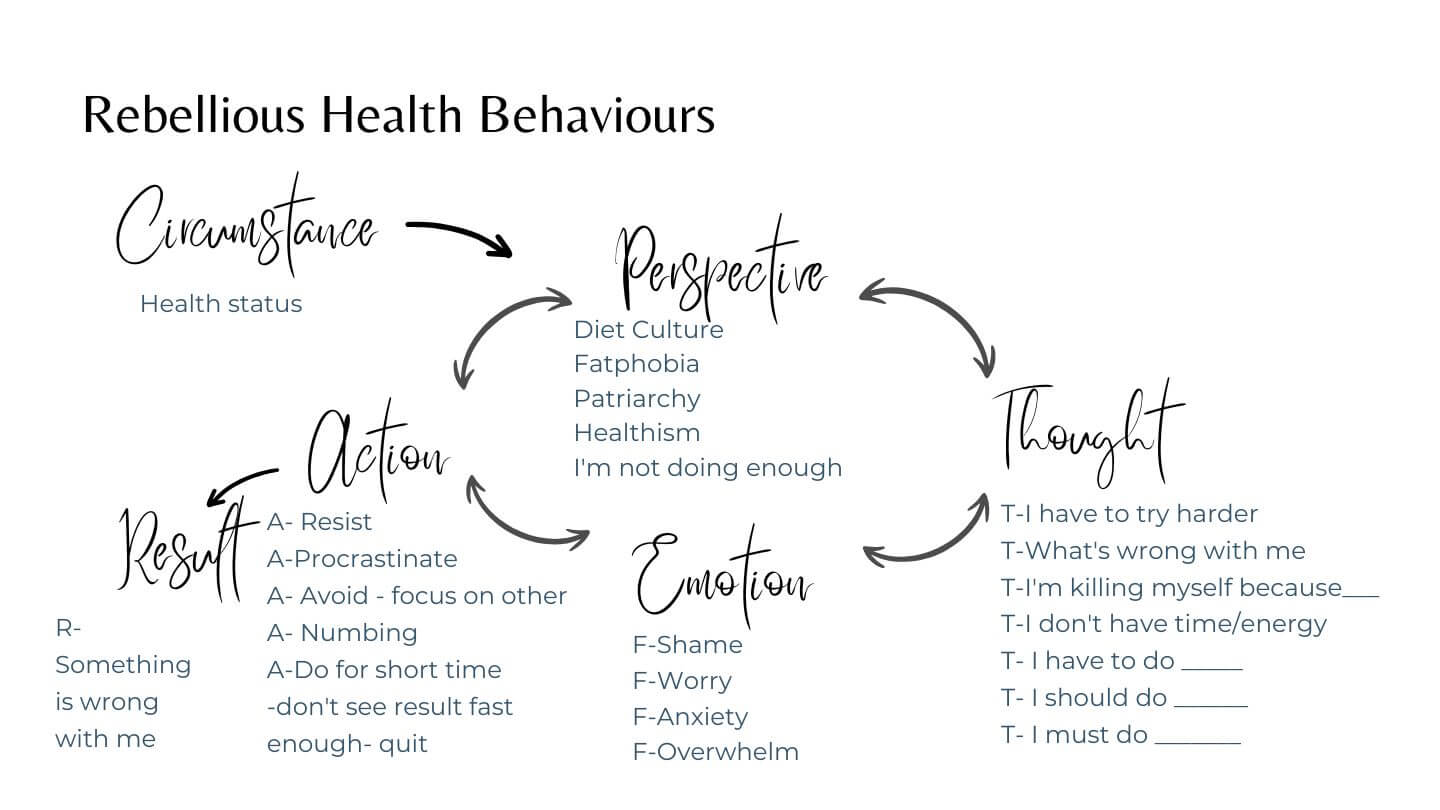

This image illustrates how circumstance, perspective, thought, and emotion create action and result—a core concept in behavioral coaching.
How Do I Help Clients Change Without Trying to Fix Them?
If you’re used to being the expert, this shift can feel uncomfortable. But here’s the secret: You don’t need to have the answer. You need to create the space.
Try This Instead:
- Ask before advising. Get curious about your client’s story.
- Name the patterns you hear. Gently reflect distorted beliefs.
- Normalize struggle. Let clients know it’s okay to have resistance.
- Co-create new definitions of health. Ones that aren’t rooted in control or shame.
For more tools, check out these questions to ask for eating behavior change.
This is not about giving up your skills as a coach. It’s about refining them so they actually work—without reinforcing harm.
The Role of Safety and Compassion in Behavior Change
No real change happens without emotional safety. Your client must feel safe to:
- Struggle
- Get it “wrong”
- Be seen and heard in their full humanity
Likewise, compassion is not a “nice-to-have.” It’s essential. If your client only feels worthy when they “succeed,” the change won’t last.
Our job is to model unconditional compassion and create the safety they need to explore, fail, and rebuild.
Ready to Coach Without the “Fix-It” Mindset?
You can access all of our services on our work with us page. We have a number of programs and service levels enabling us to serve most women:
Free Resources and Masterclasses: Get started and get to know us better!
Private coaching with Stephanie and her team Stephanie and her team of Certified Non-Diet Coaches are waiting to support you in a one-to-one setting with an individualized plan.
Non-Diet Coaching Certification for professionals ready to integrate the Going Beyond The Food Method™️ in their practice and for women wanting to become a Certified Coach and build a business coaching other women beyond the food.
Feeling Unready to Coach? Here’s Where to Start

If you’ve been thinking about stepping into coaching—or transitioning your business from weight loss to a weight-neutral model—but feel uncertain, hesitant, or “not ready yet,” you’re not alone. Most of us never feel truly ready when stepping into something new, especially when that new path challenges conventional health norms.
So let’s normalize this: feeling unready doesn’t mean you’re unqualified. It means you’re stretching. It means you care. And it might actually mean you’re exactly where you need to be.
This guide is for health professionals who want to coach differently—without promoting weight loss, and without waiting for permission. Whether you’re starting a new coaching career or shifting your existing practice, here’s where to begin.
What Does It Actually Mean to Coach?
Let’s clear something up right away: coaching is not about having all the answers.
True coaching is partnering with your client in a thought-provoking, creative process that inspires them to maximize their own potential. It’s not about delivering solutions or holding the “right” plan. It’s about helping them uncover their answers.
When you believe coaching is about being the expert with the fix, you naturally feel pressure to be perfect. Cue imposter syndrome, analysis paralysis, and a whole lot of stuckness.
But here’s the truth: your job is to guide, not to solve.
In the world of non-diet health, this distinction is everything. If you’re moving away from weight loss as a measure of success, your coaching must also shift from “doing” to “facilitating.”
Rather listen to the audio version of this blog? We’ve got you…
Why You Don’t Feel Ready (And Why That’s Normal)
“I’m not ready yet.” That voice can sound like:
- “I’m not qualified enough.”
- “I might harm someone.”
- “I don’t feel confident taking on real clients.”
Sound familiar? These are not signs that you should stop. They are signs that you’re stretching into something new.
Here’s what most people don’t realize:
Readiness isn’t a feeling you wait for. It’s a skill you build.
Confidence doesn’t come first. Action does. And the more action you take, the more confident you become.
If you want a peek into how readiness is built from the ground up, check out the Non-Diet Coaching Certification. It’s designed to help you develop the method and the mindset to coach with impact.


6 Steps to Start Coaching (Even When You Don’t Feel Ready)
1. Get Clear on What Coaching Is (and Isn’t)
Coaching is not telling people what to do. It’s not having all the answers. It’s the skill of holding space, asking better questions, and guiding people to their own wisdom.
You don’t need to be perfect. You need to be present.
2. Know Your Why
Why do you want to transition your business? Why does this path matter to you?
Clarity fuels courage. When doubt creeps in, returning to your “why” will keep you moving forward. If you’re not sure yet, try the reflection questions in the weight-neutral business transition guide.
3. Learn a Framework That Works
If you feel like you’re winging it, it’s probably because you are. And that’s OK—but it won’t help you grow.
Learning a solid coaching framework—like cognitive behavioral coaching—gives you structure. Combine that with a clear process like intuitive eating, body neutrality, or health-promoting behavior change, and you’ll stop second-guessing yourself.
Don’t just learn how to coach. Learn how to coach within your scope, with tools that align with your values.
We need more thin weight-neutral providers, too.
4. Coach for Free (Yes, Really)
Before I ever charged a client, I coached for free. 6 months before my nutrition certification. 6 months after. It was the bridge that helped me build confidence without pressure.
Reach out to past clients. Post in your community. Offer free sessions in exchange for feedback.
Inside the Non-Diet Coaching Certification, we call this peer coaching. It’s how our students build real-life experience in a supervised environment, safely and skillfully.
5. Stop Waiting for Readiness
Here’s your permission slip: You are not behind. You are not broken. Readiness is not coming to rescue you.
Build it, one step at a time.
Use tools like the Thought Ladder to shift your belief from “I’m not ready” to “I’m learning to become a great coach.”
Pro tip: Each belief level needs action to support it. Don’t wait until you feel confident. Start acting as if you’re already becoming that confident coach.
6. Commit to Consistent Effort
You don’t need to be full-time. You don’t need to be perfect. But you do need to commit.
Commit to:
- Practicing regularly
- Seeking mentorship
- Building your business skills (not just your coaching skills)
If you need support in building a business that reflects your values, check out Non-Diet Business Coaching.
You Are More Ready Than You Think
Feeling “not ready” is a sign that you’re already doing the work. The only way to move through it is to start.
Build your belief. Learn the skills. Take small actions. And know this:
You are not behind. You’re just beginning.
And that is a powerful place to be.
Need Help to Begin Your Coaching Journey?
You can access all of our services on our work with us page. We have a number of programs and service levels enabling us to serve most women:
Free Resources and Masterclasses: Get started and get to know us better!
Private coaching with Stephanie and her team Stephanie and her team of Certified Non-Diet Coaches are waiting to support you in a one-to-one setting with an individualized plan.
Non-Diet Coaching Certification for professionals ready to integrate the Going Beyond The Food Method™️ in their practice and for women wanting to become a Certified Coach and build a business coaching other women beyond the food.
How To Structure A Weight Neutral Health Coaching Session
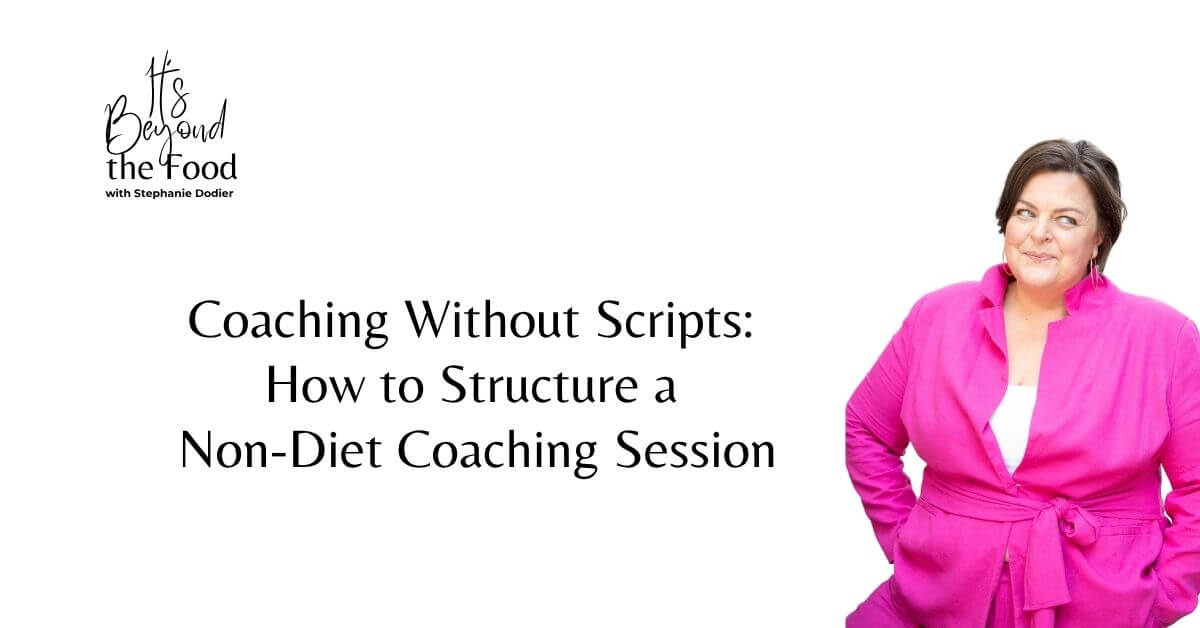

Delivering powerful, weight-neutral coaching sessions isn’t about scripts or templates. It’s about having a repeatable structure that lets you show up grounded, confident, and ready to support your client’s transformation.
If you’re a nutritionist, health coach, or wellness professional who’s moved beyond diet culture, you might be wondering: “Now that I’m not selling weight loss, what am I actually coaching on? How do I guide sessions without relying on metrics like pounds lost or calories tracked?”
This is where structure meets freedom. When you have a clear coaching framework, you’re free to respond to what your client brings without scrambling or second-guessing. You can focus on coaching — not educating, fixing, or over-prepping.
Let’s break down the core structure behind a transformative weight-neutral coaching session.
Coaching Isn’t Educating: Why Structure Matters More Than Ever
With the rise of AI and information overload, clients aren’t paying you for facts or Googleable advice. They’re paying you for:
- Emotional intelligence
- Personalized support
- Co-regulation and nuance
- Safe space to explore change
Coaching is not the same as educating. That’s why tip-based sessions, checklists, or accountability spreadsheets often fall flat. Especially in a weight-neutral approach, where transformation isn’t tracked on a scale.
Clients don’t need more tips. They need space to change.
What gives you the confidence to hold that space is a repeatable structure. One you can rinse and repeat — with ease.
Rather listen to the audio version of this blog? We’ve got you…
The Coaching Framework: Structure vs. Process
Let’s start with definitions.
- Structure is how you deliver the session.
- Process is what you deliver inside that structure.
Think of it like this: The structure is your container. The process is your content.
In the Non-Diet Coaching Certification, we teach our students how to:
- Use Cognitive Behavioral Coaching as a structure
- Deliver processes like Intuitive Eating, Body Neutrality, and Weight-Neutral Health Coaching
That structure lets you coach with clarity, regardless of what your client brings to the table.
The 3-Phase Session Flow: Learn, Build, Have
This is the framework we teach inside the Going Beyond The Food Method™, designed to guide any client toward sustainable, embodied change.
Phase 1: Learn
Goal: Set the foundation. Learn who your client is, what they want, and what’s in the way.
This includes:
- Creating liberated goals (using feminist, client-led goal setting)
- Evaluating their current habits, thoughts, and mindset
- Identifying the limiting beliefs and emotional blocks
Use tools like:
- The Wheel of Life to identify skillset gaps
- Cognitive Behavior Coaching to explore how thoughts drive behaviors
Tip: This phase is usually 2–3 sessions.
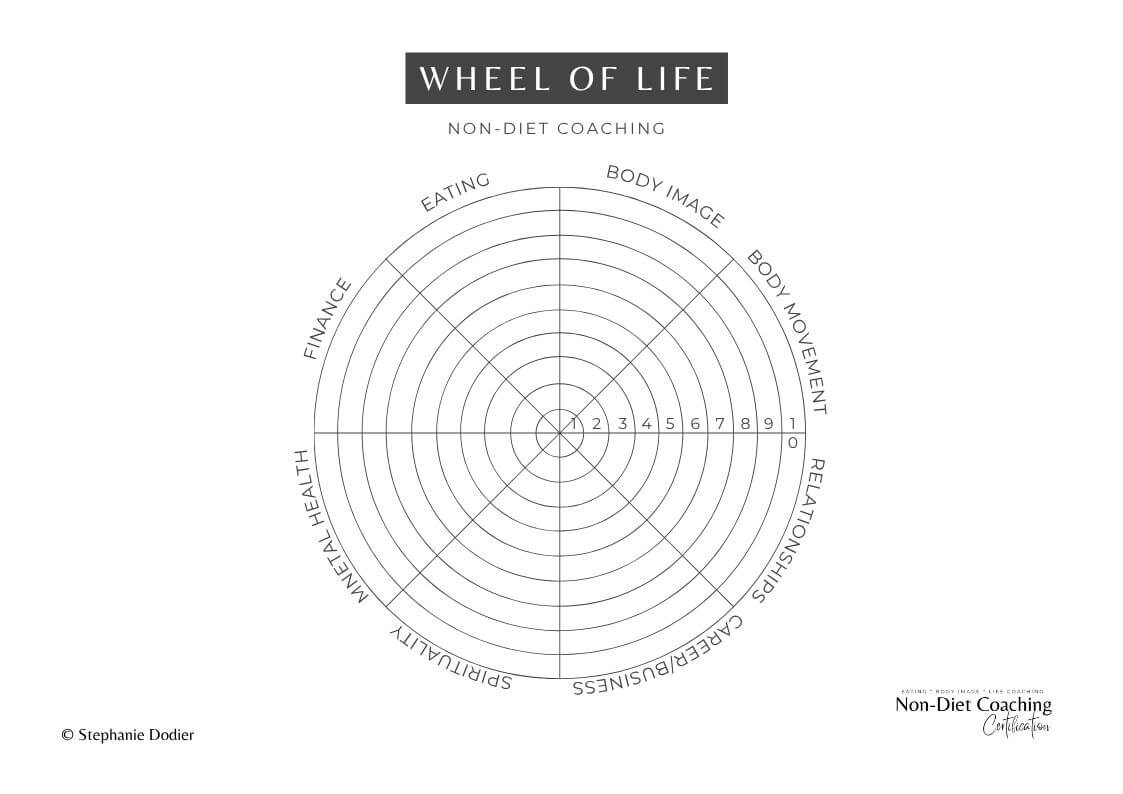

Phase 2: Build
Goal: Build the new skills and habits your client needs to reach their goals.
In this phase, you coach on:
- Developing new thought patterns
- Creating consistent behavior using tools like minimum baseline
- Addressing resistance, shame, or people-pleasing patterns
This is where real change happens.
Coaching Example: Instead of telling your client to “work out more,” you help them implement a minimum baseline (e.g., 2 walks/week for 15 minutes) and coach around what gets in the way.
This is where we coach on boundaries, time management, values, and the messy middle of behavior change.
Phase 3: Have
Goal: Sustain the transformation.
Here, your client:
- Embodies new habits with ease
- Self-regulates through setbacks
- Lives in alignment with their values
This phase is about integration, not intensity. You’re helping your client become someone who has the habit, not someone who’s trying to force it.
Mindset Is the Method
Underneath every session is the mindset structure of Cognitive Behavioral Coaching. That means you coach on:
- What thoughts are driving this feeling?
- What feeling is driving this behavior?
- What belief needs to shift to unlock the next step?
This mindset-first approach is what makes the Going Beyond The Food Method™ so powerful. It integrates mindset, eating, and body image — not as separate pieces, but as a whole.


Coaching the Whole Human
Your client isn’t just a body. They’re made up of four bodies of health — physical, mental, emotional, and spiritual.
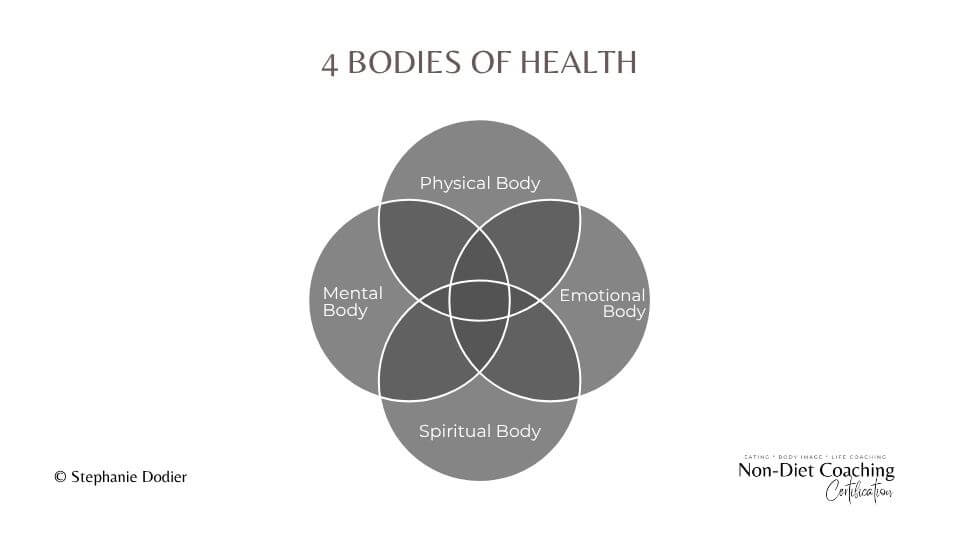

A weight-neutral session structure respects all four:
- Physical: Movement, sleep, rest
- Emotional: Nervous system regulation, grief, joy
- Mental: Beliefs, patterns, mindset
- Spiritual: Values, meaning, purpose
When your session structure makes space for the whole human, your client feels safe to transform.
What This Looks Like in Practice
Let’s say your client wants to stop binge eating.
Learn:
- Explore why bingeing happens
- Identify thoughts and feelings behind the behavior
- Use tools like the Wheel of Life to spot gaps
Build:
- Implement intuitive eating skills
- Coach on body image triggers
- Practice minimum baselines for self-care
Have:
- Normalize intuitive eating
- Maintain new patterns with less effort
- Revisit liberated goals for alignment
This structure gives you flexibility and clarity. You’re no longer winging it every session. You’re coaching with purpose.
Want to Learn This Framework?
You can access all of our services on our work with us page. We have a number of programs and service levels enabling us to serve most women:
Free Resources and Masterclasses: Get started and get to know us better!
Private coaching with Stephanie and her team Stephanie and her team of Certified Non-Diet Coaches are waiting to support you in a one-to-one setting with an individualized plan.
Non-Diet Coaching Certification for professionals ready to integrate the Going Beyond The Food Method™️ in their practice and for women wanting to become a Certified Coach and build a business coaching other women beyond the food.
A Weight-Neutral Approach to Emotional Eating
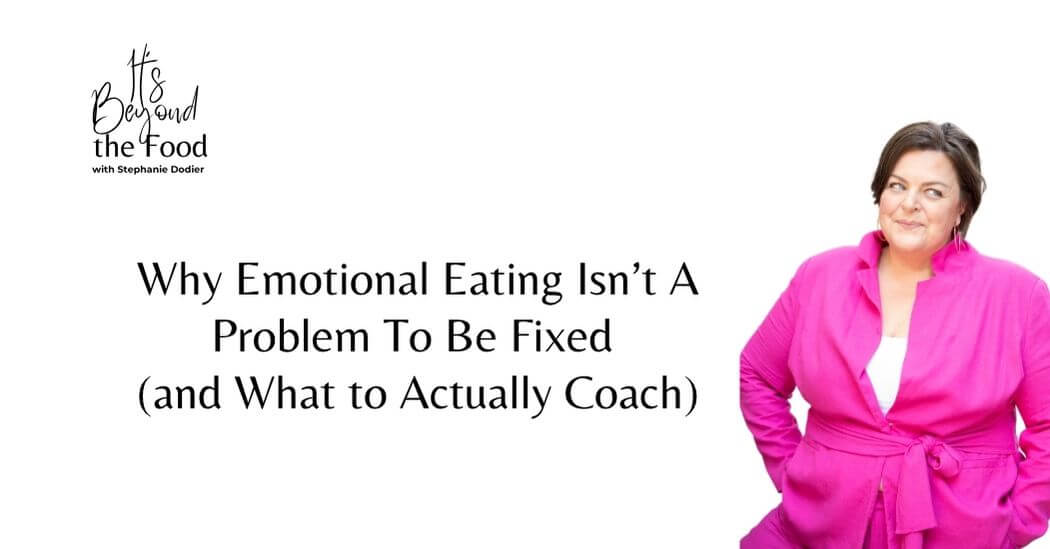

Emotional eating gets a bad rap—especially in wellness spaces where diet culture still lurks behind “clean eating” mantras and self-discipline pep talks. But what if emotional eating isn’t a problem to be fixed?
In weight-neutral coaching, we don’t pathologize normal human behavior. And yes, emotional eating is one of them.
Let’s explore a radically different way to understand and support emotional eating—one that centers curiosity, compassion, and long-term change.
Why Emotional Eating Isn’t the Problem
First, let’s get clear: emotional eating is simply eating in response to emotions rather than physical hunger. That’s it. And it’s something every human does. Think holiday meals, birthday cake, or comfort food after a tough day. None of this is inherently harmful.
So why is emotional eating treated like a moral failing?
Because diet culture taught us that any eating outside strict rules is wrong. It convinced us that emotional eating is the reason diets fail, rather than acknowledging that the diet itself is the problem.
In truth, emotional eating becomes a concern only when it’s the primary or sole strategy someone uses to regulate emotions—and even then, the issue isn’t the food. It’s the absence of alternative tools for emotional regulation.
Learn more in The Gift of Emotional Eating.
Rather listen to the audio version of this blog? We’ve got you…
Emotional Eating Exists on a Spectrum
Emotional eating isn’t black or white. It lives on a spectrum, influenced by context, motivation, and frequency.
Take these examples:
- Normal emotional eating: Enjoying holiday meals steeped in family tradition and love.
- Disordered emotional eating: Eating to numb feelings of shame, fear, or stress with no other coping tools.
Same behavior. Different context.
This is why labeling any emotional eating as “bad” misses the mark. It ignores the nuance, and it erases the humanity of the client in front of you.
Understanding the Spectrum of Eating Behavior & Body Dissatisfaction
To fully support clients, it helps to visualize the spectrum of eating behavior & body dissatisfaction behaviors. This image below illustrates how body awareness can shift into body preoccupation and even body paralysis, depending on emotional, social, and psychological factors.
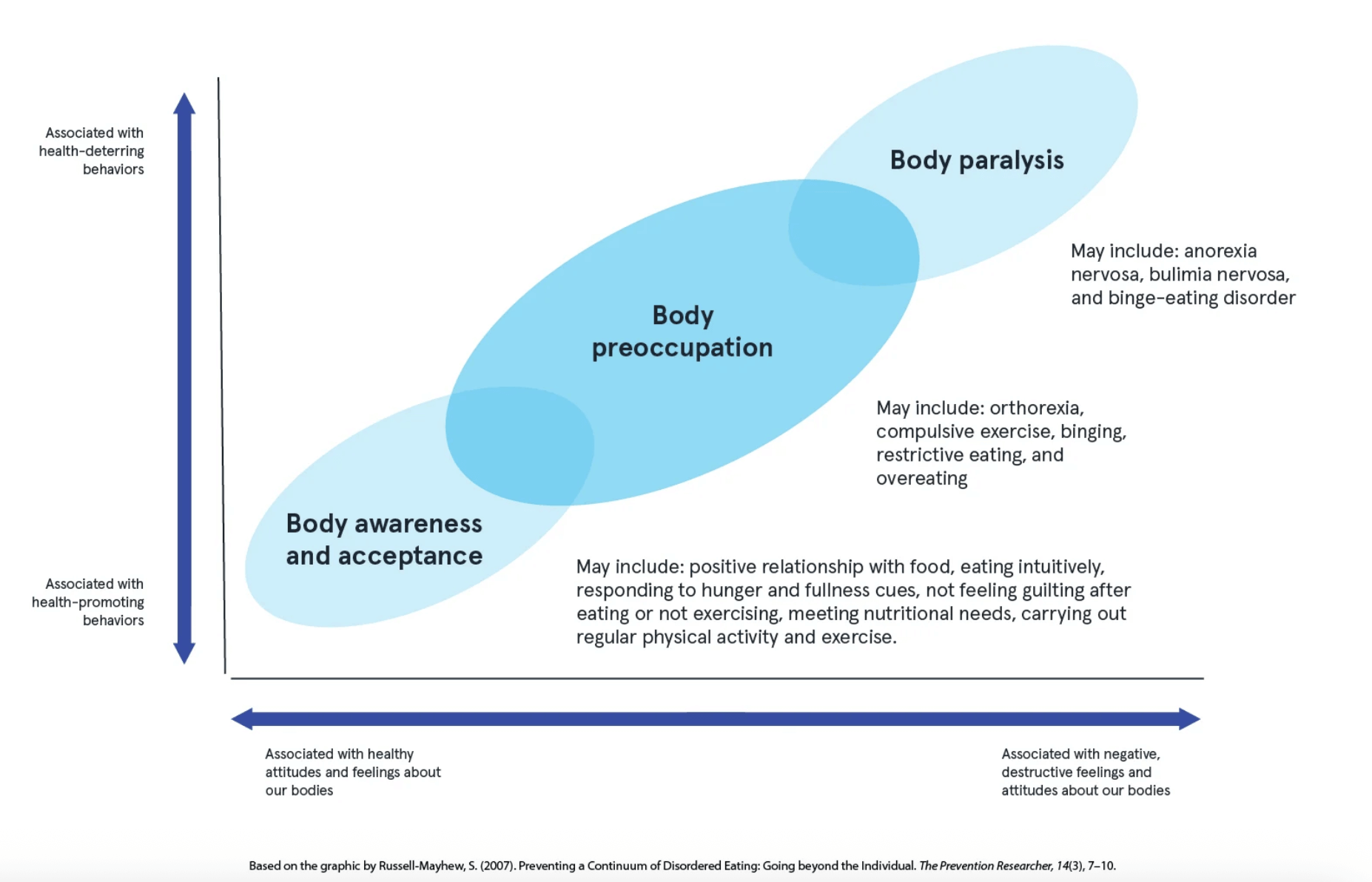

Based on the research: Preventing a Continuum of Disordered Eating: Going beyond the Individual
The Eating Pendulum: Another View on Why Emotional Eating Happens
Another helpful way to understand emotional eating is through the lens of the pendulum swing. When clients restrict their food intake—whether through dieting, clean eating, or food rules—they often find themselves swinging to the other extreme: bingeing, emotional eating, or compulsive eating. This isn’t a failure. It’s a biological and psychological response to deprivation.
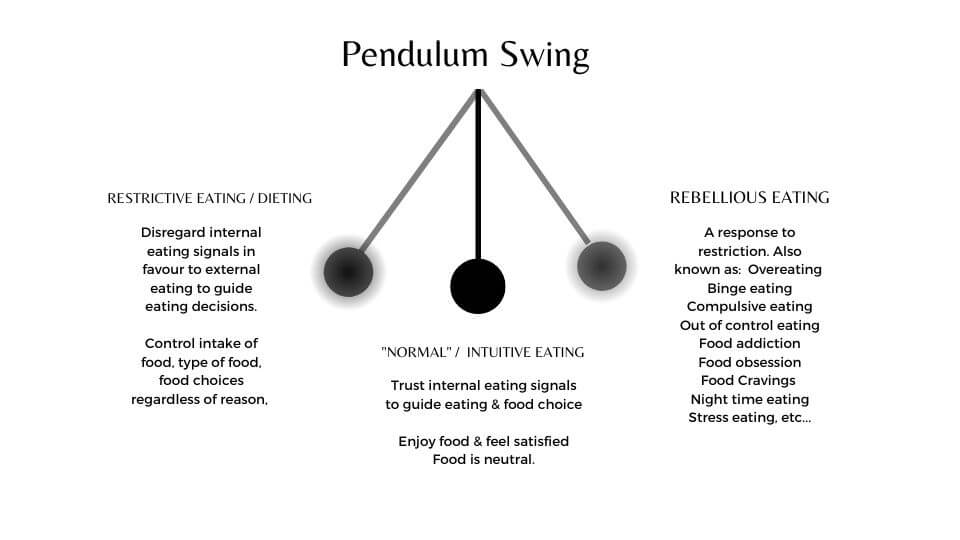

In the middle lies intuitive eating, where food is neutral, and decisions come from internal cues, not rules. Rebellion is not the problem. Restriction is. And emotional eating, in this context, is often a signal that something needs to shift.
The Real Work: Go Beyond the Food
Here’s the truth: you can’t coach emotional eating effectively if you only focus on food. You have to go beyond the plate and get curious about what’s happening underneath the behavior.
This means helping clients explore:
- What emotions trigger their eating behaviors
- How they’ve been taught to cope with discomfort
- Their beliefs about food, bodies, and worth
We use a cognitive-behavioral lens, because it helps us understand the beliefs and thoughts that drive eating behavior. We also bring in emotional and nervous system regulation skills—not to “fix” the eating, but to expand our client’s toolbox for care.
How to Coach Emotional Eating Without Reinforcing Diet Culture
Here are three coaching strategies to reframe emotional eating and support clients skillfully:
1. Normalize Emotional Eating
Start here. Teach clients that emotional eating is not a flaw. It’s a learned, adaptive behavior. It’s also an invitation to get curious.
Offer analogies: eating at a funeral or a wedding, childhood comfort meals, cultural traditions. Remind them that food has always been emotional.
2. Get Curious, Not Critical
Most clients come in ready to judge themselves. Instead, guide them to ask:
- “What am I feeling right now?”
- “What do I need right now?”
These questions open the door to self-awareness. They shift the focus from food as the enemy to the emotion as the messenger.
Teach the difference between curiosity for compassion and curiosity for judgment. That distinction changes everything.
3. Build Regulation Skills
This is where most trainings stop short. Knowing that emotional eating is normal is great. But your clients also need support learning new ways to respond to emotions.
That’s where coaching comes in. We teach emotional regulation, nervous system awareness, and body attunement so clients have more choices than just food.
Redefining Success: Behaviors, Not Bodies
A weight-neutral approach doesn’t aim to eliminate emotional eating. It aims to expand a client’s capacity to meet their emotions with compassion and choice.
When emotional eating becomes one of many tools—instead of the only one—clients start to feel empowered. And that shift doesn’t just change how they eat. It changes how they live.
Explore Intuitive Eating as a supportive path forward.
Let’s stop pathologizing emotional eating and start honoring it as the doorway to deeper healing.
Ready to Coach Emotional Eating with Skill (Not Scripts)?
You can access all of our services on our work with us page. We have a number of programs and service levels enabling us to serve most women:
Free Resources and Masterclasses: Get started and get to know us better!
Private coaching with Stephanie and her team Stephanie and her team of Certified Non-Diet Coaches are waiting to support you in a one-to-one setting with an individualized plan.
Non-Diet Coaching Certification for professionals ready to integrate the Going Beyond The Food Method™️ in their practice and for women wanting to become a Certified Coach and build a business coaching other women beyond the food.
The GLP-1 Dilemma: A Weight-Neutral Coaching Approach
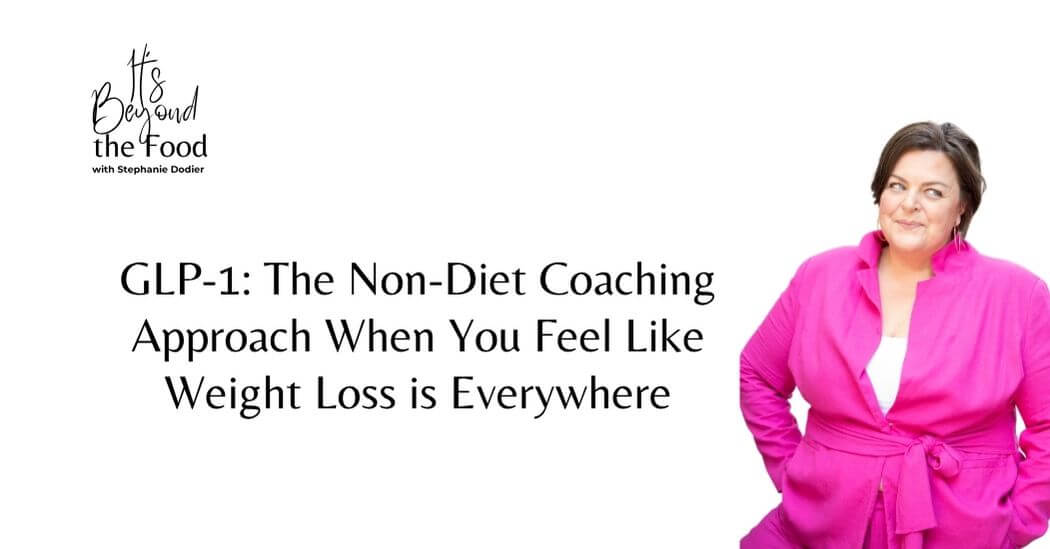

In today’s cultural climate, weight loss dominates nearly every health-related conversation. Whether it’s doctor recommendations, social media ads, or celebrity interviews, the pressure to shrink is ever-present. Now, with the soaring popularity of GLP-1 medications like Ozempic and Wegovy, that pressure has intensified.
For non-diet, weight-inclusive professionals, this can feel like an existential moment. Many are asking: How do I support my clients through this without abandoning my values? Can I remain weight-neutral while honoring someone’s interest in GLP-1s?
These questions mark a pivotal coaching evolution. Enter GLP-1 weight-neutral coaching—a framework that centers client autonomy, informed consent, and emotional safety.
The Moment We’re In
GLP-1 medications were originally developed to manage type 2 diabetes. However, when Wegovy received FDA approval for weight management in 2021, the conversation changed. These drugs began making headlines for their weight loss effects, prompting a rush of public interest.
Now in 2025, GLP-1s are everywhere. Many clients—even those who previously rejected diet culture—are reconsidering weight loss through a new, medicalized lens.
This shift is leaving many non-diet coaches feeling confused, silenced, or unsure how to respond. Some view it as a betrayal. Others retreat from the conversation altogether.
But avoidance isn’t neutral. Silence doesn’t serve your clients. And judgment won’t help them heal.
Rather listen to the audio version of this blog? We’ve got you…
What Is GLP-1 Weight-Neutral Coaching?
GLP-1 weight-neutral coaching provides an alternative path—one rooted in clarity, nuance, and respect. It rejects the binary of being “for” or “against” these medications. Instead, it offers tools to support clients in making truly autonomous health decisions.
This model is anchored in five key principles:
1. Anti-Oppression Lens
Coaching must recognize the social and systemic forces at play. Fatphobia, classism, and racism influence access to care and drive many people toward weight loss solutions. A weight-neutral coach works to resist these forces.
2. Bodily Autonomy
Every client has the right to make decisions about their body without coercion. Your role is not to approve or disapprove of their choice—it’s to create a safe space for exploration.
3. Intersectionality
Clients exist at the intersection of multiple identities. Race, gender, body size, disability, and financial status all shape their relationship to food and health. A GLP-1 conversation without acknowledging those realities is incomplete.
4. Collaboration
GLP-1 weight-neutral coaching is a shared process. Coaches don’t tell clients what to do. Instead, they co-create space for reflection, insight, and forward movement.
5. Cognitive-Behavioral Foundation
Instead of focusing solely on behavior (e.g., starting or stopping a drug), we examine the beliefs and emotions that drive it. What does the client hope to gain? What are they afraid will happen if they don’t lose weight?
The Coaching Opportunity Within the GLP-1 Conversation
Many coaches feel pressure to take a stance on GLP-1s. But that binary framing—approve or disapprove—misses the point. The real coaching opportunity lies in helping clients unpack the why.
What fear is driving the desire for weight loss? What past experiences are shaping their health choices today? What vision of wellness do they truly want to create?
Coaching questions that guide this inquiry may include:
“What are you hoping GLP-1 will solve for you?”
“If weight weren’t a factor, what would feeling good in your body look like?”
“Can we explore the possibility that you already know what you need?”
By helping clients move from fear into clarity, you offer them far more than a yes-or-no answer. You help them reclaim agency.
What the Research (Actually) Says
Most of the mainstream information about GLP-1s comes from pharmaceutical-funded studies. That means the data is often framed in ways that favor drug use.
Independent review shows:
Weight loss typically plateaus after one year of use.
Sustained weight loss requires continued medication use. Stopping often results in rebound weight gain.
74% of users report side effects, including nausea, diarrhea, and constipation.
Serious side effects—such as intestinal blockage or suicidal ideation—though rare, have been reported.
There is no unbiased long-term safety data for GLP-1s in general populations.
Cardiometabolic improvements appear to be linked to calorie restriction, not the drug alone.
Clients deserve access to this context. Tools like the patient-facing informed consent document created by Medical Students for Size Inclusivity can support this education process.
Coaching in Action: From Fear to Autonomy
Take the example of “Julie,” a 51-year-old woman recently diagnosed with prediabetes. Her doctor told her she had six months to “get it together,” or he’d prescribe GLP-1s. Terrified, she turned to coaching—not because she wanted a prescription, but because she didn’t want to become like her mother, who lives with chronic illness and limited mobility.
Julie’s fear wasn’t about vanity. It was about loss—of freedom, of identity, of life quality.
Through coaching, we unpacked her fear, discussed GLP-1 research, and explored weight-neutral health strategies. What emerged was a deeper understanding of her triggers, diet history, and emotional pain. Eventually, Julie chose a path of behavior change grounded in self-respect, not desperation.
This kind of transformation is only possible when coaching centers the person, not the medication.
The Business Side: Are You Reaching the Right Audience?
If your feed feels full of clients obsessed with GLP-1s, you may be speaking to people in the pre-contemplation or contemplation stages of behavior change. These individuals are still rooted in diet culture and may not be ready to explore weight-neutral frameworks.
Effective marketing for weight-neutral professionals speaks to people in the preparation or action stages—those who are curious, skeptical of the mainstream, and ready for something different.
This doesn’t mean you need to change your message. It means your messaging strategy might need refining.
GLP-1 as a Gateway, Not a Threat
GLP-1s are not the enemy. They are a gateway to deeper questions—questions about body trust, internalized beliefs, autonomy, and healing.
Your clients don’t need you to save them from GLP-1s. They need you to hold space for complexity, fear, and agency. They need you to help them find their voice again in a system that tells them they don’t know what’s best for their body.
That’s what GLP-1 weight-neutral coaching makes possible.
Final Thoughts
We are in a pivotal moment—one where weight loss is being rebranded as medicine, and autonomy is increasingly hard to hold. As coaches, we are uniquely positioned to resist coercion and champion client sovereignty.
GLP-1 weight-neutral coaching is not just a skill set. It’s a liberatory stance. It’s how we show up for our clients, for ourselves, and for the future of inclusive care.
If you’re ready to coach with nuance, courage, and clarity, this approach is for you.
Need Help with Weight-Neutral Coaching?
You can access all of our services on our work with us page. We have a number of programs and service levels enabling us to serve most women:
Free Resources and Masterclasses: Get started and get to know us better!
Private coaching with Stephanie and her team Stephanie and her team of Certified Non-Diet Coaches are waiting to support you in a one-to-one setting with an individualized plan.
Non-Diet Coaching Certification for professionals ready to integrate the Going Beyond The Food Method™️ in their practice and for women wanting to become a Certified Coach and build a business coaching other women beyond the food.
How to Have Weight Conversation in Health Coaching
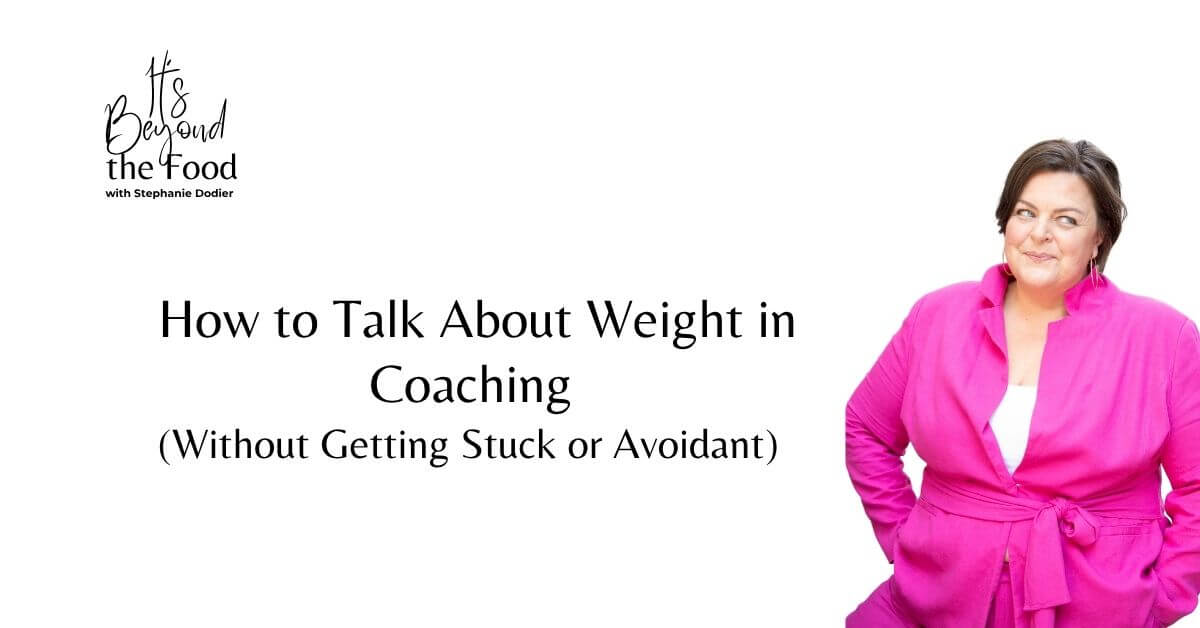

As health coaches committed to a non-diet approach, one of the most challenging conversations we face is when a client says: “But I need to lose weight.” Whether it’s during a consultation or mid-way through a coaching relationship, this statement can trigger fear, avoidance, or a rush to provide research.
Let’s reframe this moment. Instead of dreading the weight conversation in health coaching, let’s see it as an opportunity for deep, transformational work.
Why Talking About Weight Matters in Non-Diet Coaching
Many professionals freeze, intellectualize, or shut down when a client mentions weight. This reaction is normal—but not useful. We cannot guide our clients toward body acceptance and sustainable health if we can’t hold space for their real concerns.
Weight, for most clients, isn’t the problem. It’s the symbol of deeper emotional and social pain—fear of rejection, desire for belonging, or hope for improved health. Our role as coaches is not to convince them otherwise with science but to create space for their truth and gently guide them toward self-discovery.
Rather listen to the audio version of this blog? We’ve got you…
Step 1: Recognize Weight Talk as a Portal, Not a Problem
When clients express concerns about weight—be it weight loss or gain—it’s rarely about the number on the scale. Rather, it’s a surface symptom of deeper discomfort: a desire to feel safe, accepted, healthy, or less judged. The key is recognizing that weight talk is a symbol of underlying emotional, social, or physical distress. Avoiding it only reinforces shame. Instead, lean in.
Coaching isn’t about correcting beliefs with facts. It’s about exploring and unraveling them with empathy.
Step 2: Examine Your Own Relationship With Weight
Before you can effectively coach others through their body image struggles, you must unpack your own. Do weight-related comments from clients trigger discomfort, defensiveness, or judgment in you? That reaction is a cue—not a flaw. It points to areas within yourself that are still healing.
Until you can hold space for your client’s desires without attaching moral value, your nervous system will likely transmit subtle cues of discomfort. And clients are incredibly perceptive.
Step 3: Normalize, Then Get Curious
When a client says, “I need to lose weight,” your role is not to correct or convince, but to inquire. Start by normalizing their experience:
“It makes total sense that you feel this way, given what you’ve been taught about bodies and health.”
Then, dig deeper. Powerful coaching questions help clients uncover the true motives and fears driving their desire for weight change:
What does losing weight mean to you?
What do you believe will change when your body is smaller?
What makes this desire feel urgent right now?
What are you making this weight gain/loss mean about who you are?
These questions do more than gather information—they shift the client from reacting to reflecting.
Step 4: Identify the Real “Why”
As clients unpack their thoughts, patterns emerge. Most often, the weight concern isn’t about weight at all. It’s about:
Wanting to feel confident in public
Fear of rejection or not being loved
A need to avoid illness or reverse chronic symptoms
Pressure from medical providers or family
Wanting to reclaim energy and vitality
Weight becomes a scapegoat for these fears, because diet culture has conditioned us to believe it is the root of all suffering—and that changing our body is the solution.
Step 5: Lead with Compassion, Not Correction
Once the deeper drivers are revealed, mirror them back. Not as a rebuttal, but as recognition:
“If I’m hearing you correctly, it sounds like the desire to lose weight is really about wanting to feel in control of your health and avoid judgment from others.”
This is your opening to gently introduce new perspectives—around health at every size, intuitive eating, and body neutrality—without invalidating the client’s lived experience. This isn’t about preaching. It’s about offering an alternative lens.
Step 6: Explore the Pattern, Not Just the Problem
Rather than trying to change the client’s mind, guide them through examining past attempts:
When was the last time you successfully lost weight?
How did you do it?
Did it last?
Did you enjoy the process?
This helps clients see their own patterns and gently question whether weight loss is truly the solution—or just a familiar cycle with predictable disappointment.
From here, you can offer a radical alternative:
“What if you could feel more confident, energized, and in control—without having to change your body?”
This reclaims the conversation and offers clients a sense of possibility they may not have considered.
Embracing the Discomfort to Facilitate Change
The weight conversation in health coaching is not a detour—it’s the work. Holding space for clients’ weight concerns with empathy, curiosity, and skill allows for true transformation. When clients feel seen and heard—not shamed or dismissed—they’re far more open to shifting perspective. If you’d like to see how I facilitate this conversation, I created this guide: What To Say When Clients Want to Lose Weight.
This framework doesn’t eliminate discomfort. But it equips coaches to move through it with grace, purpose, and confidence. In doing so, we not only support our clients’ healing—we deepen our own.
Need Help with Weight Conversation in Health Coaching?
You can access all of our services on our work with us page. We have a number of programs and service levels enabling us to serve most women:
Free Resources and Masterclasses: Get started and get to know us better!
Private coaching with Stephanie and her team Stephanie and her team of Certified Non-Diet Coaches are waiting to support you in a one-to-one setting with an individualized plan.
Non-Diet Coaching Certification for professionals ready to integrate the Going Beyond The Food Method™️ in their practice and for women wanting to become Certified Coach and build a business coaching other women beyond the food.
Health Coach—Should You Stop Selling Weight Loss?


As a health coach, the question of whether to stop selling weight loss is one that touches not just your business but also your values and ethics. For many, weight loss programs seem like a natural fit because “it’s what sells” or “it’s what clients want.” But is selling weight loss really aligned with what you believe in?
This guide is for health coaches considering the transition to non-diet health coaching. We’ll dive into the ethical and emotional challenges of stepping away from weight loss-focused programs, share real conversations from the field, and provide a roadmap for creating a business that’s values-aligned and impactful.
Health Coaching Selling Weight Loss: Why It Feels Safe
Let’s start by acknowledging the reality: in a fatphobic society, weight loss is seen as a desirable outcome. From social media influencers to healthcare professionals, the pervasive message is that shrinking your body equals success, health, and happiness.
As coaches, we’re taught to “sell people what they want and give them what they need.” For many of us, that’s meant marketing weight loss programs to draw clients in, even if we later shift the focus to sustainable, non-diet approaches.
But here’s the thing: this model perpetuates harm.
Every time you market weight loss, you reinforce the narrative that something is wrong with your clients’ bodies. You’re not just selling a program—you’re upholding the oppressive systems of diet culture and fatphobia.
A Conversation That Changed Everything
During a recent body image coaching mentorship, I had a powerful conversation with a client about this very topic:
Client: “I wish I could join the Non-Diet Certification, but you don’t accept people who sell weight loss.”
Me: “Interesting. Why do you sell weight loss?”
Client: “Well, you know, that’s what sells. That’s what women want.”
Me: “Do you believe in the process of dieting and the sustainability of intentional weight loss long term?”
Client: “No, I don’t, and that’s why I give them the Non-Diet approach when they start working with me.”
Me: “I see. May I ask then why you are here learning from me about body image coaching?”
Client: “Well, it’s because my clients really struggle with accepting their bodies. I need to get better at helping them.”
Me: “So let me make sure I understand: you don’t believe in dieting or intentional weight loss. You don’t coach your clients to use dieting tactics. You’re here learning from a fat nutritionist and interested in advancing your skills. The only thing between you and your desires is releasing weight loss as a promise. Why do you think you’re resisting?”
Client: Silence. “I’m afraid of what will happen.”
Health Coaching Selling Weight Loss: The Fear of Letting Go
That fear is real—and valid. We live in a culture that rewards weight loss marketing with clicks, sign-ups, and praise. Moving away from selling weight loss can feel like stepping off a cliff without a safety net.
For many, the fear stems from internalized fatphobia and the belief that clients won’t invest in programs that don’t promise weight loss. This fear often manifests as:
- Worry about losing clients.
- A dip in revenue during the transition.
- Uncertainty about how to market non-diet services.
A Personal Journey: Trusting Your Values
I’ve been there. Eight years ago, I was a nutritionist selling weight loss programs despite not believing in their long-term effectiveness. I felt stuck, scared, and unsure of how to move forward without compromising my integrity.
But I made the leap. I stopped selling weight loss, embraced non-diet health coaching, and built a business rooted in my values. Was it easy? No. Was it worth it? Absolutely.
Here’s what I’ve learned:
- Trusting your intuition and aligning with your values is the foundation for sustainable success.
- Your ideal clients—the ones ready to do meaningful work—will find you.
- Stepping away from weight loss programs allows you to create deeper, more fulfilling client relationships.
What Happens When You Stop Selling Weight Loss
When coaches transition to non-diet health coaching, they often report significant positive shifts in their business and personal fulfillment:
- “I’m calling in my ideal clients who are ready to do the work.”
- “I stopped selling weight loss, and my program packages are selling better.”
- “I’m working with clients who are fun to coach and aligned with my values.”
- “I feel confident and clear in my business decisions.”
Why Non-Diet Coaching Works
Non-diet health coaching isn’t about ignoring health or behaviors—it’s about focusing on sustainable changes that don’t hinge on weight loss. Clients learn to:
- Build healthier relationships with food.
- Explore movement that feels joyful, not punishing.
- Develop self-compassion and body acceptance.
By shifting the focus away from weight loss, you empower clients to make changes rooted in self-care, not shame.
Health Coaching Selling Weight Loss: Practical Steps to Transition to Non-Diet Coaching
If you’re ready to stop selling weight loss, here’s how to begin:
- Clarify Your Values: What do you stand for as a coach? Write down your values and let them guide your decisions.
- Educate Yourself: Learn the principles of non-diet coaching and health at every size (HAES).
- Audit Your Marketing: Remove language that promises weight loss and replace it with messaging about sustainable health and well-being.
- Address Your Fears: Reflect on what’s holding you back and seek support from mentors or peers.
- Lean into Community: Surround yourself with other non-diet professionals who can offer guidance and encouragement.
Health Coaching Selling Weight Loss: Is It Time to Stop Selling Weight Loss?
Ultimately, the decision to stop selling weight loss is deeply personal. It requires courage, reflection, and a willingness to disrupt the status quo. But the rewards—both for your clients and your business—are profound.
By letting go of weight loss as a promise, you free yourself to build a coaching practice that aligns with your values and supports lasting change.
Are you ready to make the leap?
Need Help Transitioning to Non-Diet Health Coaching?
You can access all of our services on our work with us page. We have a number of programs and service levels enabling us to serve most women:
Free Resources and Masterclasses: Get started and get to know us better!
Private coaching with Stephanie and her team Stephanie and her team of Certified Non-Diet Coaches are waiting to support you in a one-to-one setting with an individualized plan.
Non-Diet Coaching Certification for professionals ready to integrate the Going Beyond The Food Method™️ in their practice and for women wanting to become Certified Coach and build a business coaching other women beyond the food.
We Need Thin Weight Neutral Health Coaches and Providers


The weight-neutral health coaching space is a movement that’s transforming how we approach health and well-being. At its core, this philosophy embraces health at every size, rejecting the traditional focus on weight loss as a measure of success.
While the space has grown significantly, an important conversation remains: the role of thin weight-neutral health coaches and providers. This essay explores why we need people of all body sizes in this space, especially thin providers, and how they can use their position to create meaningful change.
What Does It Mean to Be a Weight-Neutral Health Coach?
Weight-neutral health coaches prioritize behaviors over outcomes. Instead of promoting weight loss, they focus on sustainable habits like intuitive eating, joyful movement, and stress management. This approach helps clients improve their health and relationship with their bodies without fixating on the scale.
For weight-neutral coaching to truly thrive, it requires diversity among its providers. That means welcoming coaches of all body sizes—thin, fat, and everything in between.
Why Thin Coaches Are Vital to the Weight-Neutral Space
There’s a misconception circulating that thin coaches don’t belong in weight-neutral spaces because they benefit from thin privilege. However, this perspective oversimplifies the impact thin coaches can have.
1. Representation Matters: Clients entering the weight-neutral space for the first time may feel more comfortable with a thin coach, especially if they have internalized fatphobia. For some, seeing someone they perceive as “acceptable” can create a bridge to understanding.
2. Leveraging Privilege for Good: Thin coaches have a unique ability to acknowledge and challenge the privileges they benefit from, creating safer spaces for clients in larger bodies.
3. Expanding the Movement: The inclusion of thin coaches helps normalize the idea that weight-neutral approaches are for everyone, not just people in larger bodies.
Rather watch the video version of this blog post? We’ve got you…
I recorded a podcast episode a few years back where we discuss thin privilege in health coaching with Alissa Rumsey and Julie Duffy Dillon.
Understanding Thin Privilege in Weight-Neutral Coaching
Thin privilege is the societal advantage people in smaller bodies have simply because they fit the cultural ideal. It shows up in ways like:
- Being accommodated in public spaces.
- Having access to clothing that fits.
- Not facing discrimination from healthcare providers.
In weight-neutral health coaching, thin privilege can impact the client relationship. To foster trust, it’s essential for thin coaches to acknowledge and address this dynamic openly. Doing so creates an environment where clients in larger bodies feel seen and respected.
My Personal Journey with Thin Coaches
Nine years ago, as I began recovering from diet culture, I was hesitant to work with a fat coach. My internalized fatphobia was so strong that I couldn’t face my own body reflected back to me during coaching sessions.
Instead, I found my first weight-neutral health coach in a thin-bodied woman. She had never struggled with body image the way I had, but she held a safe space for me when I couldn’t do that for myself. She taught me to process emotions, practice self-compassion, and confront my internalized fatphobia.
That coach was the catalyst I needed to eventually work with someone in a larger body. Without her, I wouldn’t have been ready to take the next step in my journey.
How Thin Weight-Neutral Coaches Can Support Clients of All Sizes
If you’re a thin coach or provider entering the weight-neutral space, here are actionable steps to ensure you’re creating inclusive, empowering spaces for your clients:
1. Acknowledge Your Privilege: Be transparent about the advantages you’ve experienced in your body. Naming this privilege helps build trust.
2. Hold Safe Space: Learn how to create an environment where clients feel supported and validated, regardless of their size.
3. Educate Yourself: Understand the unique challenges faced by people in larger bodies, including systemic fatphobia and weight stigma.
4. Use Your Voice: Advocate for body diversity and weight-neutral approaches in professional spaces and on public platforms.
5. Practice Self-Compassion: If you feel guilt about your privilege, channel it into positive action instead of self-criticism.
Training Weight Neutral Coaches: The Skills That Matter
To be an effective weight-neutral health coach, whether thin or fat, you need more than good intentions—you need skills. Some essential coaching skills include:
- Understanding Belief Systems: Helping clients uncover and change harmful thoughts about their bodies.
- Nervous System Regulation: Teaching clients how to manage stress and emotions in a way that supports long-term health.
- Creating Safe Spaces: Building environments where all clients feel respected and empowered.
- Intersectional Coaching: Recognizing how factors like race, gender, and socioeconomic status intersect with body size and health.
The journey to becoming a skilled weight-neutral coach begins with doing the work on yourself first. By examining your own biases, beliefs, and behaviors, you can show up authentically for your clients.
Why Diversity Strengthens the Weight-Neutral Movement
Diversity in coaching bodies isn’t just a bonus—it’s a necessity. Having coaches of different sizes, experiences, and backgrounds enriches the movement and ensures it meets the needs of all clients.
Thin weight-neutral coaches bring the ability to bridge gaps for clients who might not be ready to confront internalized fatphobia. Fat coaches offer lived experience and insights that thin coaches simply can’t replicate. Together, they create a more inclusive, powerful movement.
Weight Neutral Health Coaches: A Call to Action
If you’re a thin coach considering entering the weight-neutral space, know this: your presence matters. You have the potential to make a profound impact on your clients’ lives by challenging diet culture and promoting true health.
Likewise, if you’re a client seeking a weight-neutral coach, remember that the right coach for you might not look the way you expect. What matters most is their ability to create a safe, supportive space for your journey.
The weight-neutral health coaching movement needs all of us—thin, fat, and everything in between. Together, we can challenge societal norms, reject diet culture, and create a world where health is accessible to everyone, regardless of body size.
How We Can Help You Become a Weight-Neutral Coach
You can access all of our services on our work with us page. We have a number of programs and service levels enabling us to serve most women:
Free Resources and Masterclasses: Get started and get to know us better!
Private coaching with Stephanie and her team Stephanie and her team of Certified Non-Diet Coaches are waiting to support you in a one-to-one setting with an individualized plan.
Non-Diet Coaching Certification for professionals ready to integrate the Going Beyond The Food Method™️ in their practice and for women wanting to become Certified Coach and build a business coaching other women beyond the food.
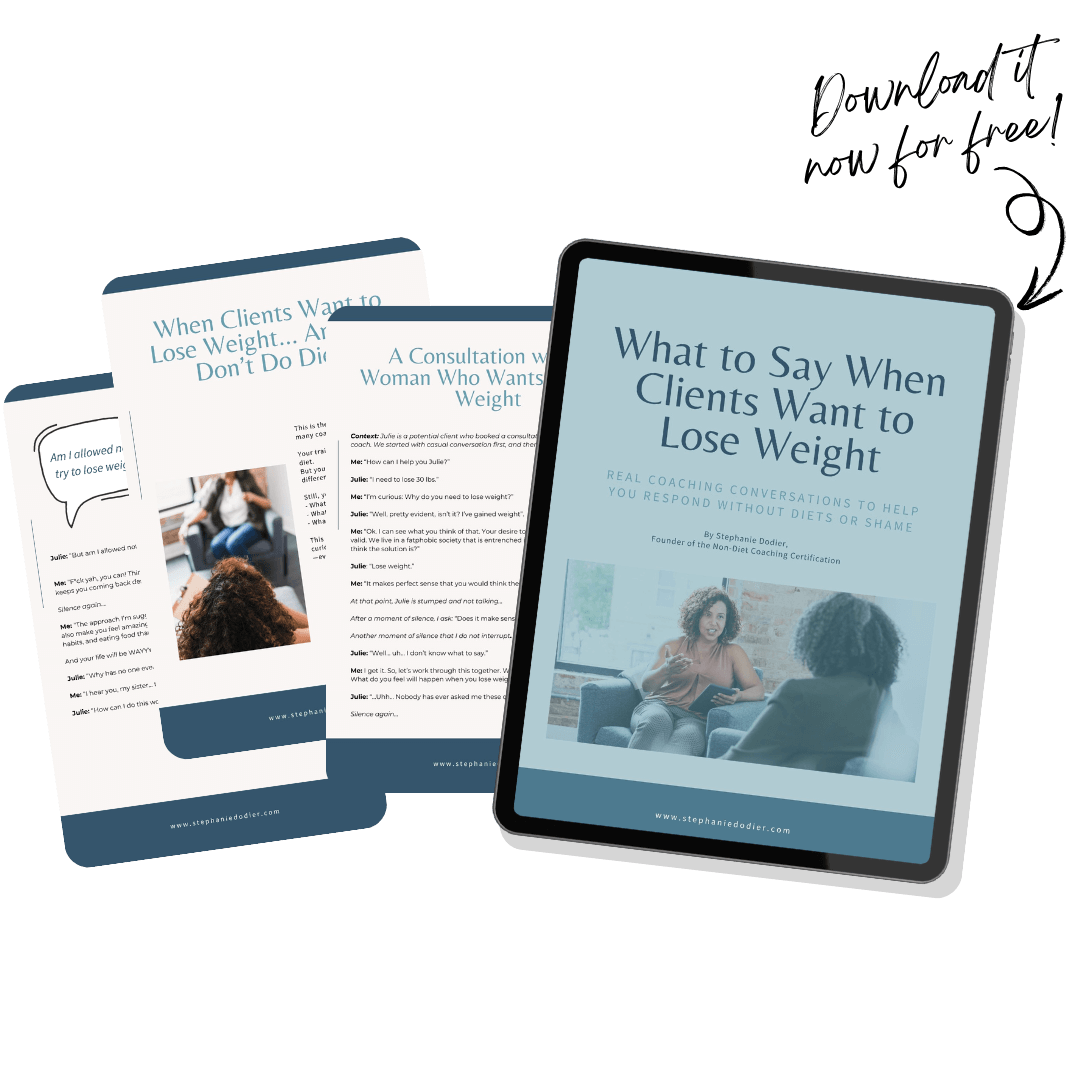

FREE GUIDE
What to say when a client want to lose weight
GET THE EXACT WORDS I USE IN REAL COACHING SESSIONS—WHEN WEIGHT LOSS COMES UP AND I’M HOLDING A WEIGHT-NEUTRAL STANCE


FREE GUIDE
What to say when a client want to lose weight
Get then exact word I use in real coaching session when weight loss comes up and I’m holding a weight-neutral stance
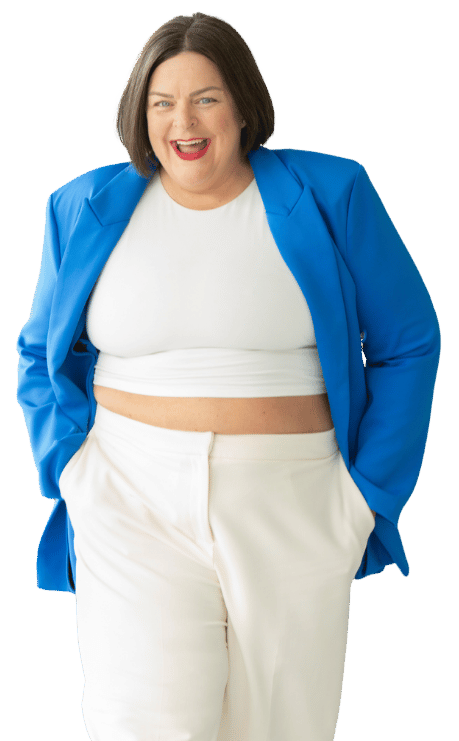

Welcome!
I’m Stephanie Dodier
I am a non-diet nutritionist, educator, and feminist business leader challenging everything we’ve been taught about food, health, and coaching.
I help health professionals confidently coach food and body without co-opting diet culture.
Join me in leading the health coaching revolution!
Ready? Let’s do this!

